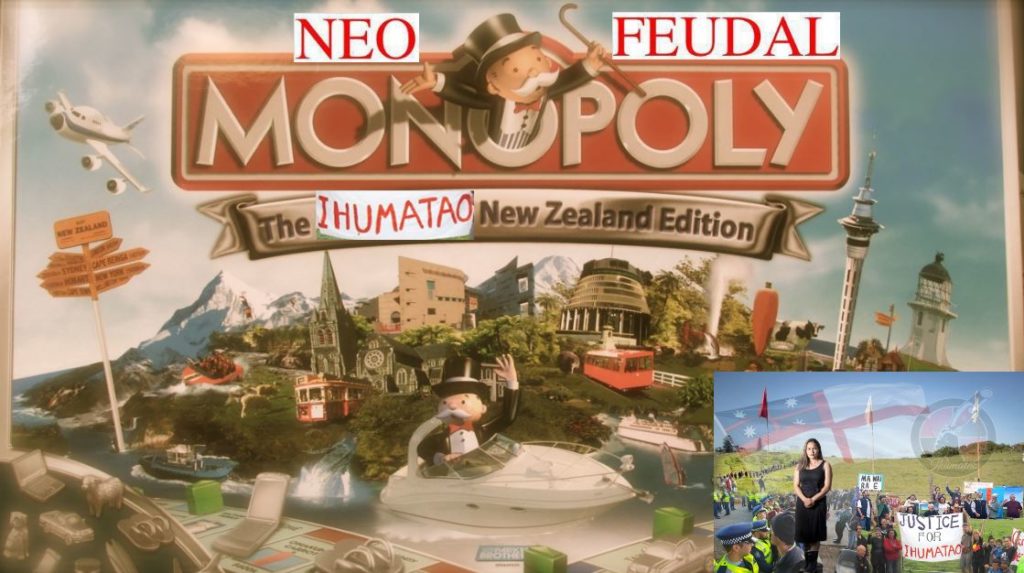
In this exposé, The Snoopman reveals Fletcher Building Ltd was granted waivers that lay bare the institutional racism of the Crown, the Council and the Courts. Not only were ministerial waivers required for a crucial breach of the Overseas Investment Act to get the Ihumātao land deal approved before the conditional sale agreement time-window ended.
With official documents – some heavily redacted – a picture of collusion is shown to have taken place between the Auckland Council, the Overseas Investment Office, the Key Ministry Cabinet, the Environment Court and the Ardern Coalition Government. Across the governance system, a horrendous story emerges of avoidance to conduct a serious sustained investigation to establish why exactly the bona fide tangata whenua of Ihumātao were stonewalled in their attempts to assert customary rights, while the ‘master plan’ of transnational bank-owned Fletcher Building was fast-tracked.
The contrived ignorance posturing extends to three Māori Labour Caucus members of the Ardern Coalition Government whom knew at least as far back as September 2015 that the Ihumātao Peninsula was never Te Kawerau ā Maki iwi’s traditional ancestral lands. This means the Ardern Coalition Government enjoined itself in the contrived ignorance game of the Auckland Council, the Courts and other Crown agencies whom pretended that Te Warena Taua represented the local iwi of Ihumātao.
The Snoopman, 1 February 2020
Fletchers Collected a Waiver Card in Neo-Feudal Monopoly game
Fletcher Building has maintained throughout the Ihumātao land dispute that every move it made was within the law. It would be more accurate to say the law had their back.
To get the Ōruarangi housing development at Ihumātao through a significant regulatory hoop, a joint waiver was required by two Key Ministry Crown Ministers in early September 2014 to over-ride breaches to the Overseas Investment Act of 2005.

This special treatment reflects the institutional racism endemic in the Crown, the Auckland Council and the Courts since all forums have overlooked the downplaying, dismissal and denigration of local iwi and hapū interests in the land – as The Snoopman showed in his exposé “Te Warena Taua – The mandated kaumātua who authored his own use-by-date?”
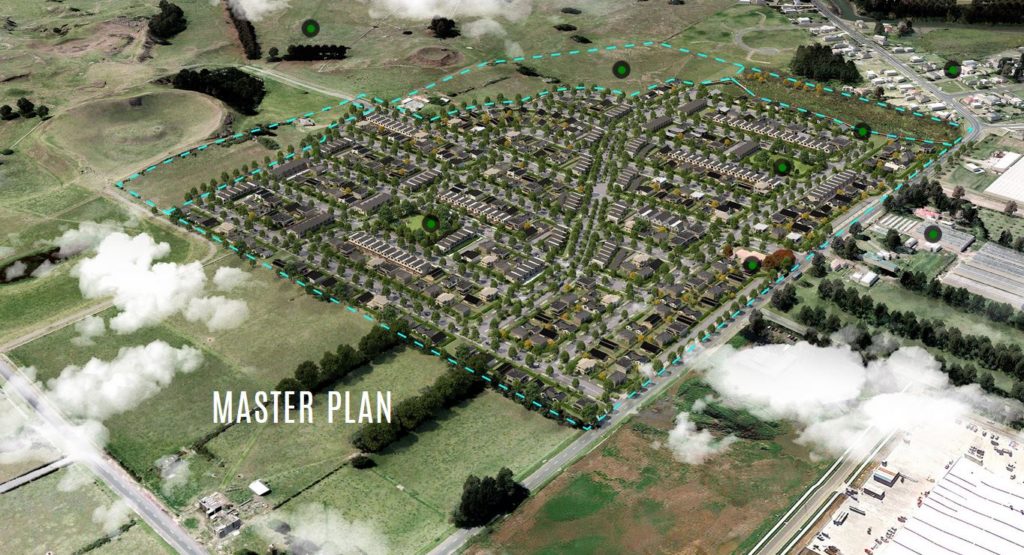
The consent application letter, sent by law firm Simpson Grierson on behalf of Fletcher Residential, makes it perfectly clear that they are well aware that their client is seeking to buy sensitive farm land adjacent to a historic reserve. Furthermore, Simpson Grierson and their client are perfectly aware that the inherent weakness of the applicant’s request for approval from the Overseas Investment Office is that the vendor had not advertised this sensitive land for sale. This weakness is not explicitly stated. Rather, a whole subsection, “Farm Land” contains justifications about why the land cannot be construed as rural.
Audaciously, Simpson Grierson partner, Greg Allen, finished the letter with special pleading, asking that the OIO treat the application for consent to buy sensitive land as commercially sensitive. Specifically, Mr Allen stressed the need for the purchase price and Fletcher Residential’s Business Plan to be kept confidential.
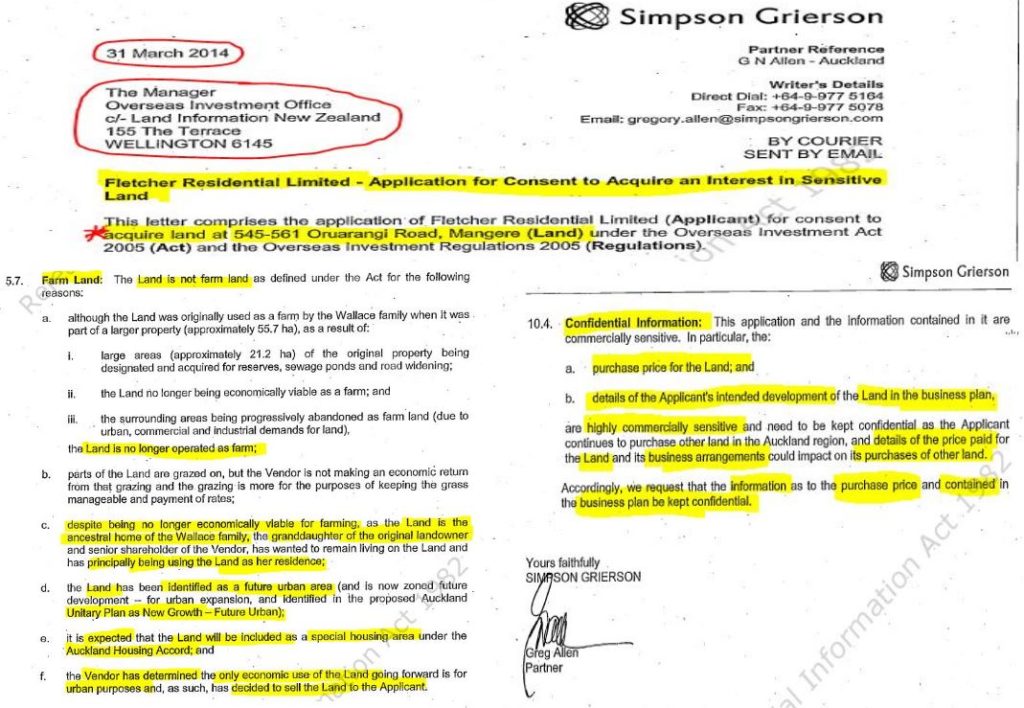
The Wallace-Blackwell Family company, Gavin H Wallace Limited, owner of ‘the Wallace Block’ – as the highly contested land at Ihumātao is locally known – failed to advertise the farm land on the open market prior to sale to the transnational construction company, Fletcher Building.
The Overseas Investment Office required a waiver because the Overseas Investment Act was breached, since sales of rural properties are meant to be advertised for sale in the 12-month period preceding an application to approve a purchase by an overseas buyer. This weak provision is designed to provide to an opportunity for New Zealanders to buy rural properties before the lands pass into overseas hands.
You would expect that lands that are located adjacent to ‘sensitive land’ such as historic reserves would require a higher threshold, as well as lands with historical significance to Māori and waahi tapu sites with burial caves.
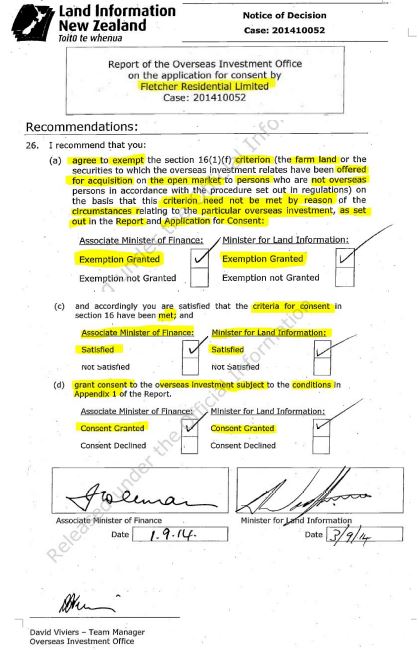
In a May 2nd 2014 letter, the Overseas Investment Office’s senior solicitor, Tyne Schofield, wrote a query to Simpson Grierson regarding the fact that land in question is rural land (and that it had not been designated as a Special Housing Area at the time that the conditional sale was signed on March 20th 2014).
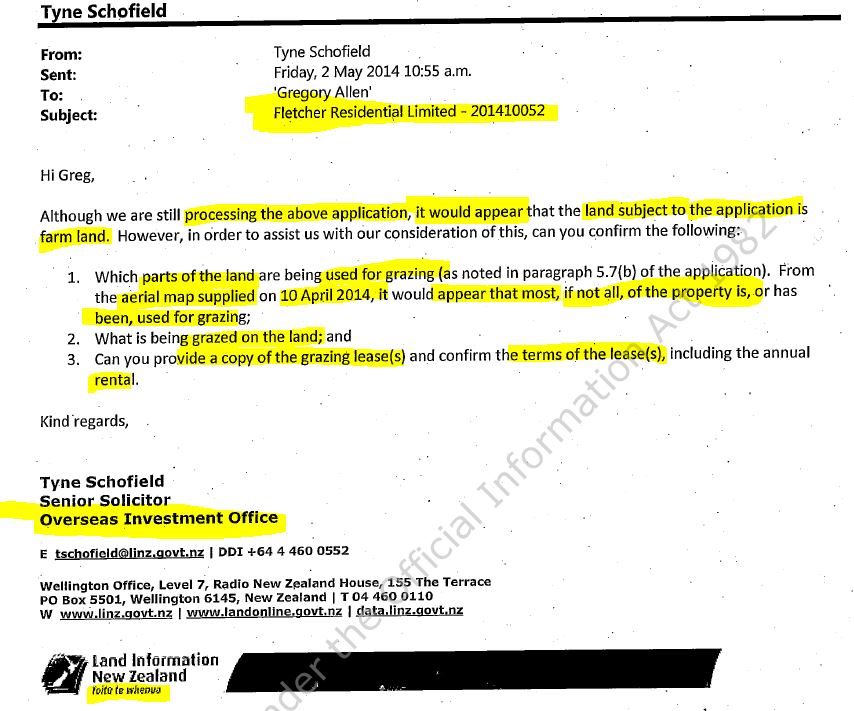
In response, the law firm, Simpson Grierson, acting for Fletcher’s international investors, indicated that the Fletcher Residential Limited would seek an exemption to the requirement to advertise the land to give New Zealanders the opportunity to buy the land.
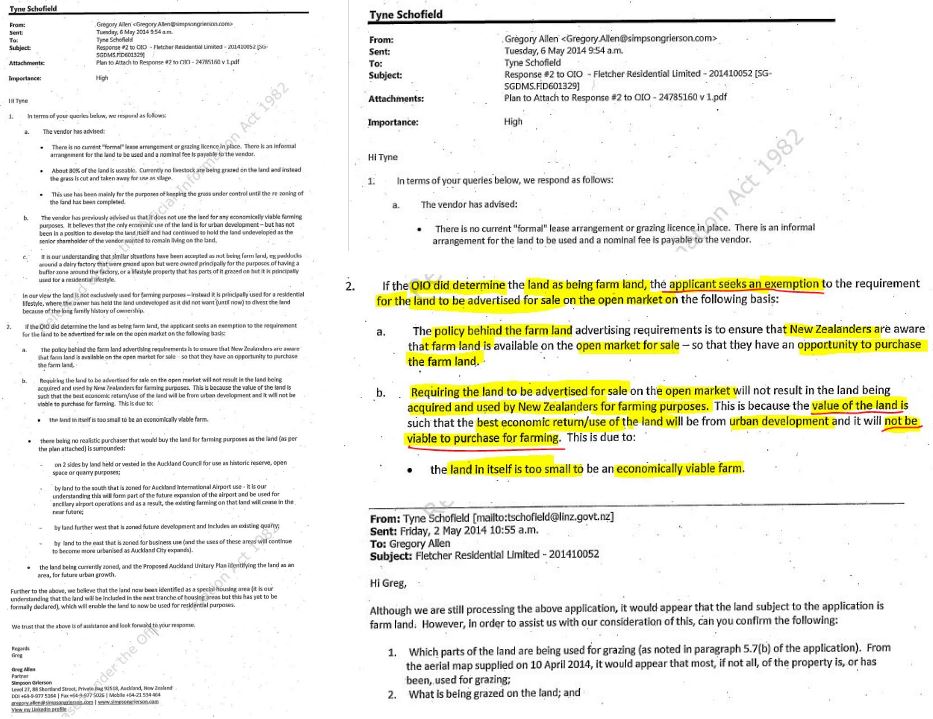
In a four-page letter dated 12 June 2014, Simpson Grierson partner Greg Allen claimed the Wallace Family vendor company, was occupying the land primarily as a residence, and holding the land for development and not for farming purposes.
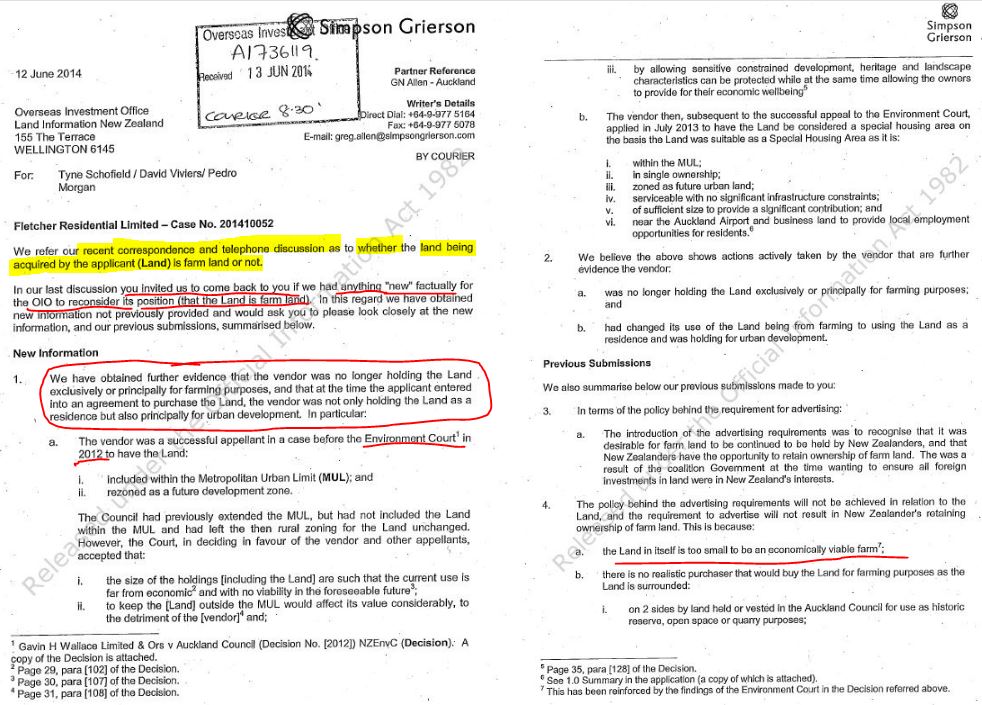
The law firm also pointed out that the Wallace-Blackwell Family had won a case in the Environment Court in 2012 to get the land designated within the Metropolitan Urban Limit and had also been “active” in getting the land included as a Special Housing Area (SHA). Simpson Grierson also advised the Overseas Investment Office that the applicant, Fletcher Residential, was willing to make a condition of consent that the acquisition could only proceed if the land gained SHA status and all other consents were gained. In this subtle way, the country’s dominant housing developer was applying pressure to the OIO, since the construction company was saying in a codified way that the deal would fall over and put in jeopardy many other developments on lands acquired with overseas investors.

Gavin H Wallace Ltd had asked Auckland Council for the land to be designated a Special Housing Area, according to Leonie Hayden in her excellent investigative piece, When Worlds Collide, published in NZ Geographic – although she does not state when the Wallace land company made the request. According to the Overseas Investment Office, Gavin H Wallace Ltd applied in July 2013 to have the land designated as a Special Housing Area. Fletcher Residential CEO Steve Evans says the construction company did not apply for the SHA status, but supported that process. Evans’s vague answer to Ian Sinclair in 2016 for TVNZ‘s Sunday programme was in place of saying Fletcher Residential advised Council in November 2013, that it intended to build at Ōruarangi.
The result of this communication traffic was that the Overseas Investment Office stuck to its stance that the land in question was rural farm-land, despite attempts attributed to the Wallace-Blackwell Family to construe it otherwise. These withheld documents were Fletcher Building’s business plan, a schedule of enquiries received from marketing the property and a letter between Simpson Grierson and conveyancing law firm, John Heard, about a variation to the sale and purchase agreement.
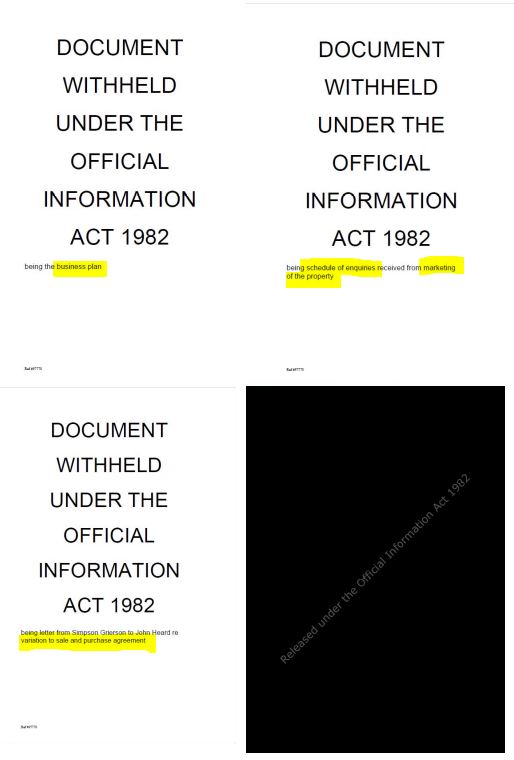
In July and August of 2014, when it was advertised in a couple of local newspapers, the adverts failed to state any identifying location numbers such as the street, lot or property title numbers. A TradeMe add only got as specific as a Property ID number which would have meant little to people, especially since the map of Mangere did not indicate where the property for sale was located. This behaviour strongly suggests the seller, the buyer and the law firm, Simpson Grierson, were simply performing the appearance of complying with the Overseas Investment Act – after the fact of the application being lodged – and did not want to alert the real obstacles to the transfer of land title to an overseas buyer: tangata whenua.
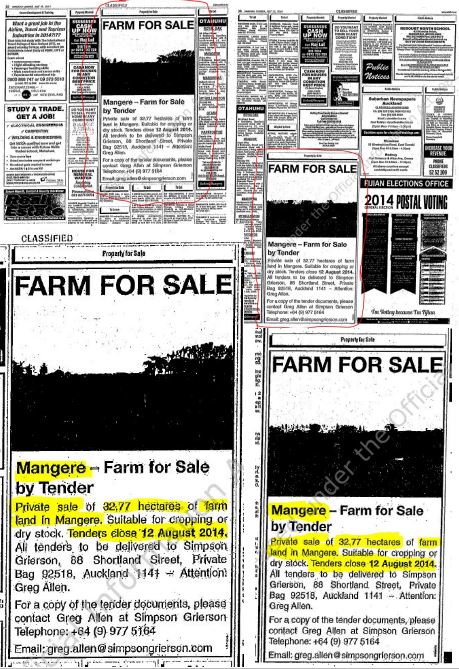
Simpson Grierson, gained a waiver from two Crown officials in the Key Coalition Government at the beginning of September 2014 after writing to the Overseas Investment Office.
The Crown officials – Jonathan Coleman, the associate minister of finance and Michael Woodhouse, the Minister of Land Information – signed the waiver, despite the fact that when the land was advertised in a couple of local newspapers in July and August of 2014, the adverts failed to state any identifying location numbers such as the street, lot or property title numbers. The ads simply stated the rural property was “Mangere Farm For Sale”. A TradeMe ad that ran for a month from mid-July 2014 only provided a Property ID number, but no street address, or road location. The ad contained a note stating the map “only shows general area where the property is located”. In other words, Simpson Grierson was acting in bad faith to stretch it’s Pākehā Special Privilege (or PSP) as far as it could without breaking the OIO’s colluding cover.

When it approved Fletcher Residential’s application, the Overseas Investment Office performed intellectual gymnastics and essentially stammered as it tried to justify why the breaches to the rural land advertising requirements were somehow in ‘accordance’ with the regulations.
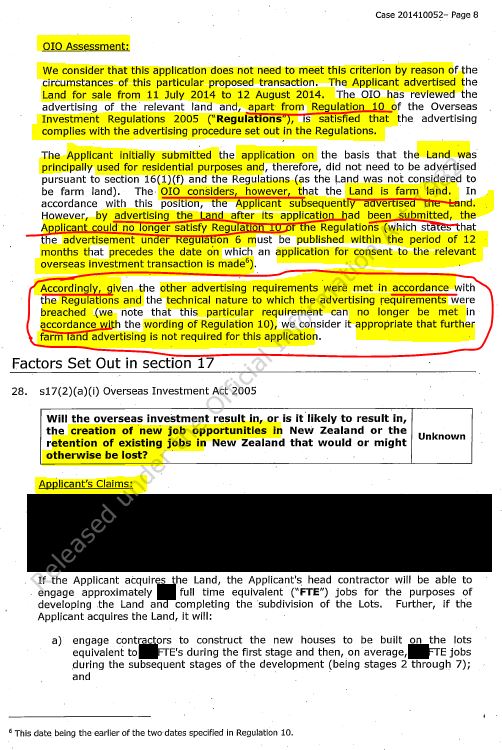
Fletcher Building Limited – whose subsidiary company, Fletcher Residential, reached a conditional purchase and sale agreement on March 20th 2014 with Gavin H Wallace Limited for $19 million – needed the ministerial waiver or the deal would have fallen over in 2014.
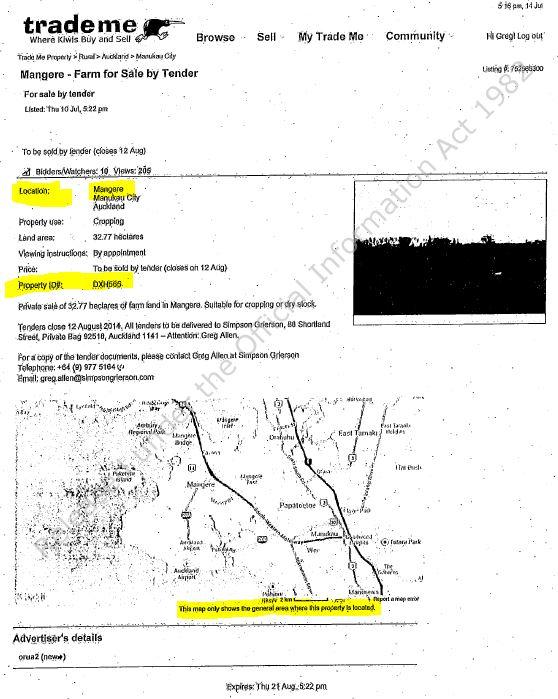
The waiver signing Crown officials – Jonathan Coleman and Michael Woodhouse – also approved Fletcher Buildings application despite the fact that no third parties had been consulted. Although the provision section 29 of Housing Accord Act of 2013 appeared to supply justification for avoiding negotiating the acquisition of lands, it did not over-ride the Overseas Investment Act regarding sensitive rural lands and the need to negotiate with the correct tangata whenua. Crucially, a condition of the consent was that the information provided to the Overseas Investment Office or the relevant Ministers was required to be accurate at the time it was provided. This raises the critical matter of lying by omissions. The applicant played its part in a contrived ignorance game about the ‘failure’ to advertise the property prior to the applying the OIO.
This avoidance occurred because both parties were well aware that tangata whenua interests on the Ihumātao Peninsula had the potential to be a significant obstacle. After-all, Te Warena Taua – who was the chairman of three committees at the local Makaurau Marae – had fought for the Wallace Block to remain in pristine condition as rural land, stating it had tapu sites on it, during an Environment Court hearing in 2012. The Wallace-Blackwell Family’s land company, Gavin H Wallace Ltd, was successful in getting the land re-designated within the Metropolitan Limits. And while it will be shown that Mr Taua is not of the local iwi with traditional tangata whenua ancestral roots, he had the potential to use his clout, networks and standing to ‘rally the troops’ to mount an effective resistance.

Mr Taua’s narrative has been that following the defeat in Environment Court in 2012 to stop the Wallace-Blackwell Family gaining a zoning change for ‘the Wallace Block’, he changed his approach. However, Mr Taua has remained vague about when exactly he switched from challenging developments to engaging with Fletcher Residential to supposedly forge a better relationship, including the time-frames that the chairman of Te Kawerau Iwi Tribal Authority and the Makaurau Marae Maori Trust allegedly gained a reduction in house numbers from 520 to 480. Indeed, Mr Taua has repeatedly claimed there was no legal means for him to stop the sale and the development. Yet, a condition of the OIO approval was a requirement to conduct an archaeological survey. Given that Mr Taua had claimed in 2012 that the Wallace Block contained archaeologically significant sites that were tapu, Mr Taua’s subsequent favourable Cultural Impact Assessment in support of the Fletcher development has never been sufficiently explained.

Not least because the Wallace Block was categorized as sensitive land’ because it adjoined the Ōtuataua Stonefields Historic Reserve. Furthermore, the land holds potency for the local tangata whenua because it was farmed by their ancestors and because the lava caves on the farm land were also burial caves. These facts were known to the Wallace-Blackwell family, the Auckland Council and the Crown. In other words, the contrived ignorance game supported the game of speed, whereby the application gained the green-light and the appearance that it was an unstoppable locomotive.
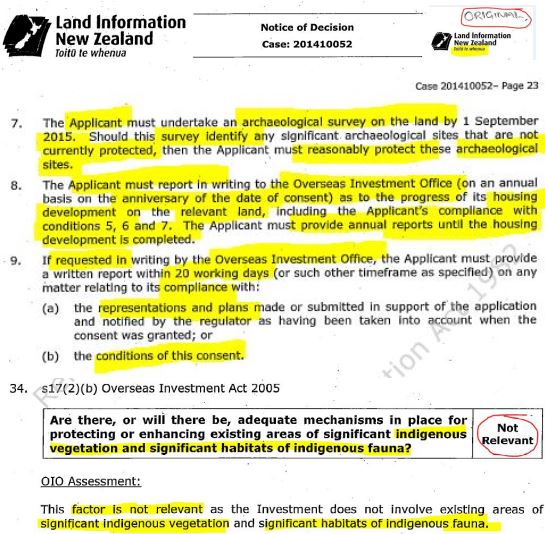
Therefore, a weaponization of time was inbuilt into the Fletcher land deal. Fletcher Residential advised Council in November 2013, that it intended to build at Ōruarangi – as Ian Sinclair reported for TVNZ‘s Sunday in 2016. It is fascinating that Fletcher Residential CEO Steve Evans said the construction company did not apply for the SHA status, but supported that process. Fascinating, because it somehow neglected to support the Wallace-Blackwell Family advertising sale process on the open market prior to lodging its apllication to the Overseas Investment Office. Fletchers’ apparent case of ‘corporate dementia’ about its ownership structure magically meant that the local community at Ihumātao was unable to mount a fight until after the transnational construction company was conferred with special treatment by two Crown ministers. In this under-handed way, the foreign-owned construction transnational moved stealthily, and with unseemly speed to gain new development space by weaponizing time. As the speed of events unfolded at a quickened pace, Fletcher Residential found the law had its back every step of the way, until the attempted eviction, arrests and groundswell of public support of July 23 2019 triggered the Pākekā-dominated Ruling Class to manage the crisis rituals – lest the Ihumātao Land-Grab Scandal snowballed into a full-blown governance crisis.
Special Treatment Card – For Foreign Bankers’ Use Only
During the Ihumātao land dispute between 2015 and 2020, the news media have carefully avoided spelling out to their audiences why exactly Fletcher Building needed Overseas Investment Office approval. To maintain their contrived ignorance, the news media – including the Māori Media – have avoided reporting the transnational construction company’s ownership structure, despite the Protect Ihumātao campaigners frequently appearing with a banner depicting the transnational owners of Fletcher Building.
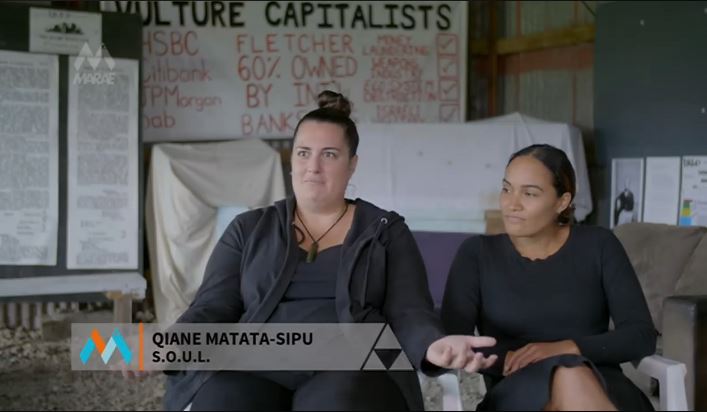
Three transnational banks own 54.09% of the Fletcher Building consortium, which transmogrified out of the Fletcher Challenge conglomerate. These three transnational banks are: HSBC which owns 26.48% of Fletcher shares, while JP Morgan Chase Bank holds a 16.15% stake and CitiBank controls 11.46% in stocks. A further 2% is owned by asset management company, FNZ Custodians, which like HSBC, JP Morgan and CitiBank, owns stocks in a company called Rubicon, which was set up in 2001 to facilitate the takeover Fletcher Challenge Energy (which grew out of the state-owned PetroCorp) by Shell and Apache Corporation – as business analyst Brian Gaynor said in “Selling all our assets makes New Zealanders ‘serfs in our own country’”.
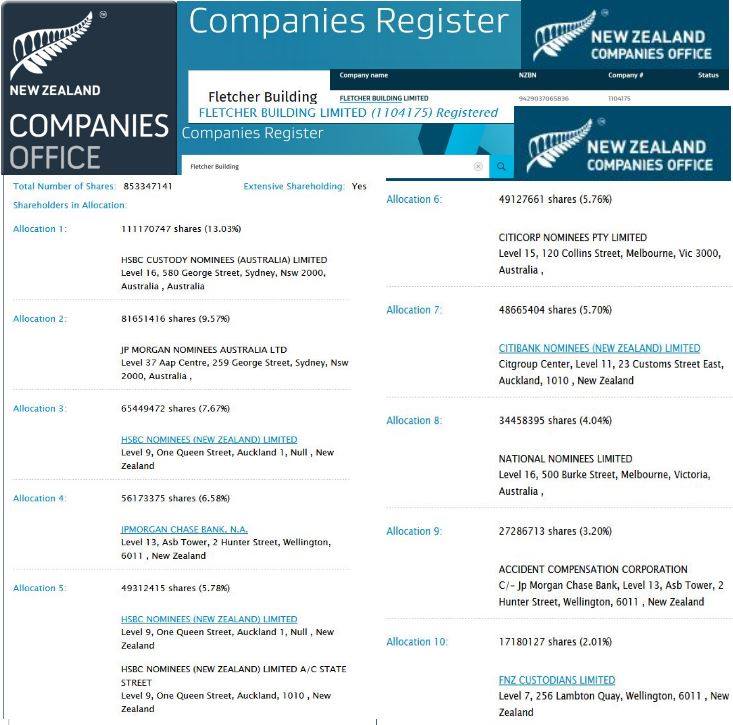
Ironically, the contested Ōruarangi Block housing development at Ihumātao was marketed as one project to alleviate Auckland’s acute housing supply crisis. This housing crisis, which is really about affordability, is ultimately caused by the ongoing economic warfare framework that was inflicted by a Neo-Feudal Confederacy, whom orchestrated the corporate takeover of New Zealand between mid-1984 and 1994, with Fletcher Building’s corporate ancestor Fletcher Challenge playing an instrumental role – as The Snoopman’s shows in his exposé – “Deep History of Ihumātao: The Fletcher-Rockefeller-Rothschild Dynasties Connection [Mud-sticking version]”.
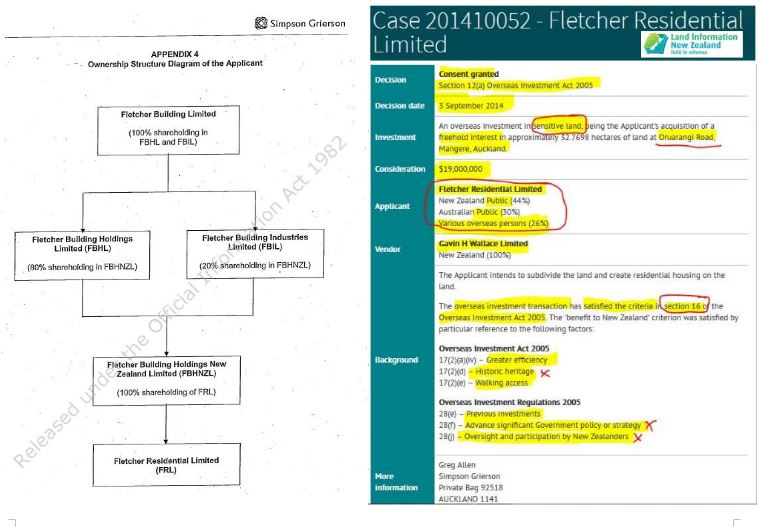
The 33-hectare Ōruarangi Block gained rapid approval because the land was re-designated as a Special Housing Area by the Key Ministry Cabinet on 1 July 2014, with the support of the Auckland Council’s Housing Projects Office, the Auckland Council Development Committee and Auckland City Councillors. This approval by the Key Government’s Cabinet shows that ‘the law’ really did have Fletcher Building’s back amid a citywide land grab.
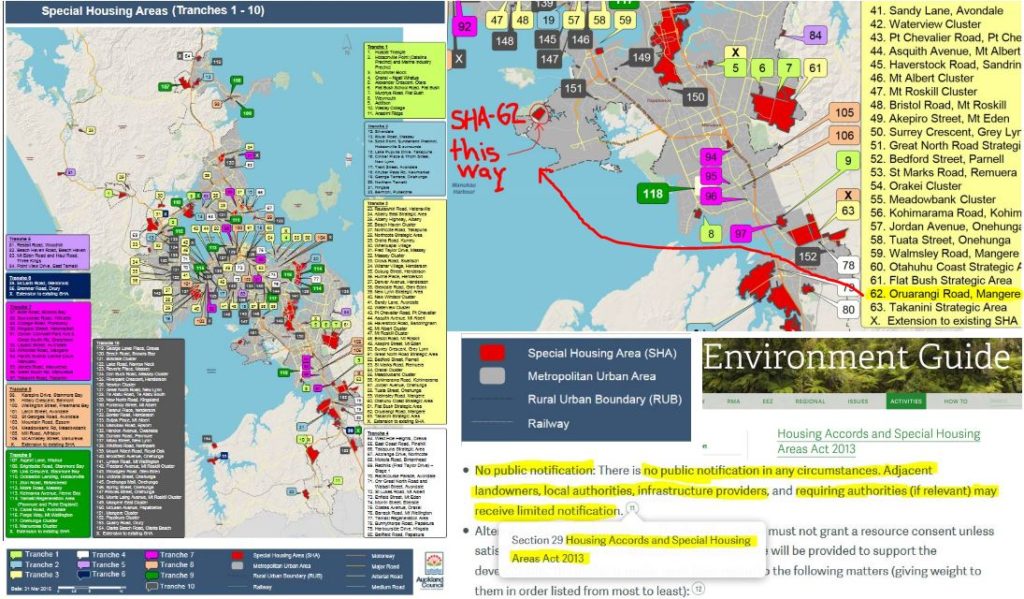
Without mentioning even once the pronoun, ‘Māori’, the Overseas Investment Office could maintain a contrived ignorance that no third parties needed to be consulted, despite the fact that the property was categorized as ‘sensitive land’.
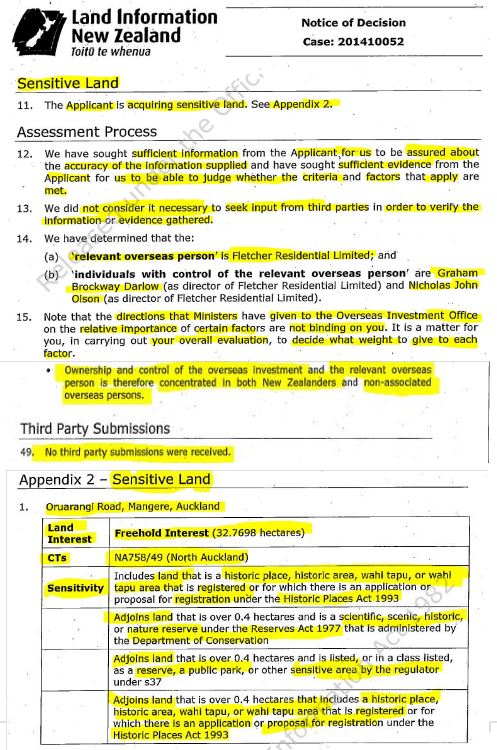
Pick Up a Dial-a-Kaumātua Card
Yet, approximately six months later, on 17 September 2014, Radio New Zealand reported that Te Kawerau ā Maki iwi kaumātua, Te Warena Taua, was threatening the Auckland Council with court action because he claimed the Council had not consulted with Te Kawerau ā Maki people living at Ihumātao. In its report, Radio NZ gazetted that the Auckland Council advised at the time that it was now up to Fletcher Building to consult with the tribe directly, while Fletchers evidently said it is prepared to talk with the mana whenua. Strangely, this report, “Court threat over housing accord”, recorded that the Fletcher development project up to 480 houses would be built.
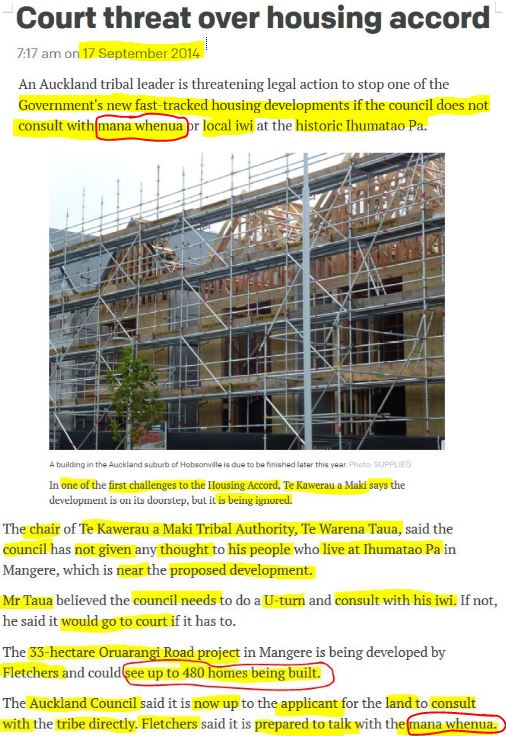
Strange, because Mr Taua has often bragged that it was through his efforts in negotiating a better deal for his iwi, that he gained concessions from Fletcher Building – including the construction firm agreeing to reduce the number of houses from 520 down to 480. This figure of 480 homes is not only mentioned in this RNZ report of 17 September 2014. As we shall see, it was also reported that Fletcher Building’s Overseas Investment Office application stated up to 480 houses would be built. As Dr Raonui reported on Waatea News, Fletcher Building’s Overseas Investment Office (OIO) application was filed eleven days after the Wallace-Blackwell Family entered into a sale and purchase agreement for $19 million on March 20 2014. In its assessment, the Overseas Investment Office appear to use a lower band for the housing project, but the text is black-out and only shows a figure of “415 to” in a section discussing how the housing application will likely advnace the Special Housing Accord to fast-track the construction of new homes. This lower band may be 415 to 480 houses.
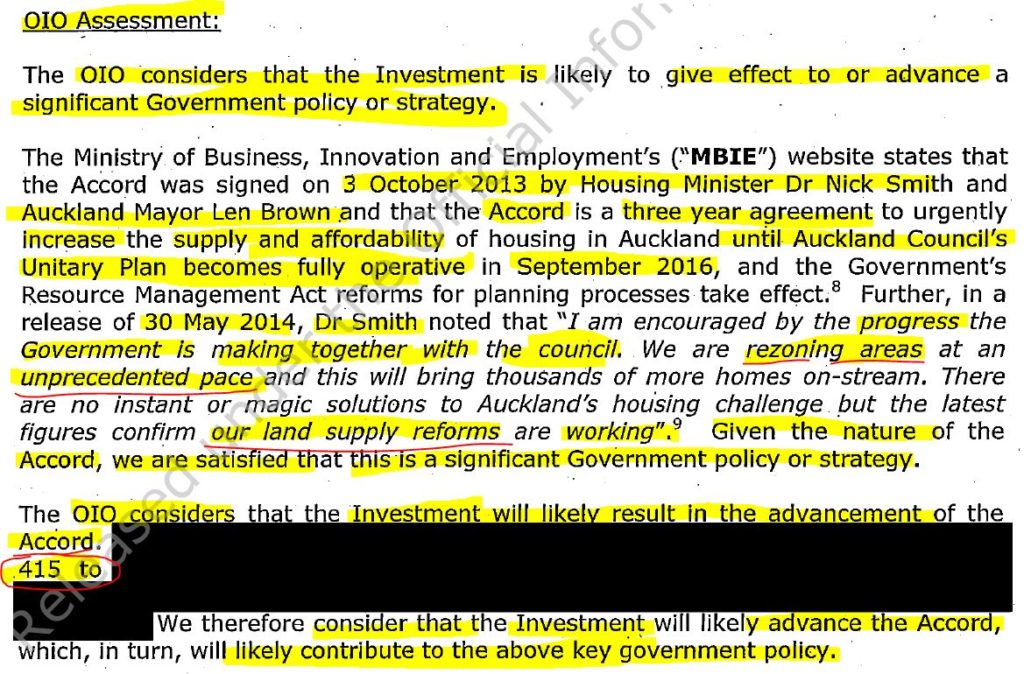
Stranger still, is the fact that Mr Taua was complaining that the Auckland Council has not consulted with him as the chief of his iwi – whom he claims are the mana whenua of Ihumātao. And in response, the Auckland Council passed the proverbial buck to the Housing Accord applicant – Fletcher Building – to now consult with the tribe and in turn Fletcher Building says it is willing to talk with the “mana whenua” over a housing project that magically reduced in scale from 520 houses down to 480.
This metadata of reduced number of houses to be built also turns up as part of Te Warena Taua’s narrative spinning two days after he accompanied Police, Fletcher Building CEO Steve Evans, and numerous Māori Wardens to evict the Ihumātao occupation group. In a press release of 25 July 2019 attributed to Te Kawerau ā Maki, it claimed Mr Taua had said that his iwi had worked hard to intervene in a private sale between a farming family and Fletcher Building several years ago, but had no legal recourse to stop the transaction. However, Te Kawerau ā Maki supplied no evidence to back up Mr Taua’s assertion that the iwi had actually “worked hard to intervene in a private sale between a farming family and Fletcher Building several years ago”. In its press release, Te Kawerau ā Maki a quote from Mr Taua:
“We decided the next best thing was to negotiate with Fletchers to win significant rights and concessions for our people. Fletchers agreed to protect the view of our maunga and reduce the housing development from 520 to 480 homes and enable our people to own 40 of them via a shared equity scheme – better than anything we have ever achieved from Housing New Zealand or the Crown.”

Thus, Mr Taua claimed in the July 25 2019 press release head-lined “Mana whenua sets the record straight”, that as a result of his efforts, Fletcher Building reduced the number of houses from 520 to 480. Mr Taua claims he went to the Wallace Homestead at 561 Ōruarangi Road, Ihumātao, The timing of when has been vague in many accounts, including Mr Taua’s own public statements.

On TVNZ’s Marae, July 28 2019, Mr Taua said he visited Mrs Blackwell to see if he could buy ‘the Wallace Block’, but he evidently was told the sale had already happened. Taua added there was nothing he could do legally to intervene and so he turned his efforts to mitigation. Mr Taua said:
“I went to see Ailsa, the owner of the land to try and buy the land back. We had money to buy the land back. She couldn’t. She was very clear that if they sell the land, they could only sell it to Fletchers. And there was a legal agreement. So the best thing was to see what we could get back for our people. Land is coming back – eight hectares. Now that is coming back at no cost to us. But also homes for people. Now, you know what we’ve fought long and hard. I’ve settled the iwi with the Crown and I know the work and how hard it is to get land back. It’s not going to come any other way.” – Te Warena Taua, Marae.
After his encounter Aisla Blackwell, Mr Taua says he next visited Fletcher’s Steve Evans. Mr Taua said he did so to get a law change to change things, he told the Auckland Council on August 27 2015 when SOUL petitioned the Pākehā ‘Old Boys Network’ that controls the Town Hall. Warren Taua has also claimed he met with Fletcher Building to develop a business partnership for his iwi – as he had said many times, before TVNZ‘s Te Karere reporter Te Rina Kowhai aired the story of Mr Taua’s joint venture investment deal with Dianne Lee of Tahi Enterprises – before a wider audience three hours after The Snoopman scooped the exposé Te Warena Taua – The mandated kaumātua who authored his own use-by-date? – perhaps because the Crown-owned broadcaster only has $375 million in assets.
Like his alleged visit to Ailsa Blackwell, his meeting with Mr Evans of Fletcher Building appears to have occurred after Te Kawerau ā Maki signed a Treaty settlement with the Neo-Colonial Crown on 22 February 2014 and after the Wallace-Blackwell family company signed with Fletchers on 20 March 2014. In his public statements about when he actually went to the Wallace Homestead at 561 Ōruarangi Road, Ihumātao, Mr Taua has been vague. Mr Taua has not clear whether he learned of the Wallace-Blackwell-Fletcher land deal around March 20 2014 or if it were at a later date, perhaps in early September 2014.

Fascinatingly, the Crown, the Council and Courts have not taken the initiative to construct a comprehensive timeline of events, including a cast of characters using network analysis software, and GPS-located off-the-record meetings that might have taken place in mansions, koru lounges or on yachts.
What is clear is that the Makaurau Marae community did not know in February 2015, when they first met to discuss planned development, was how close Taua was to the orbit of Fletcher Building.

Instead of battling with the Auckland Council – as the chairman of Te Kawerau a Maki Tribal Authority said he would in mid-September 2014 if the local authority did not do a u-turn – Te Warena Taua would go on, not only to write a Cultural Impact Assessment in 2015 in support of Fletcher Building’s development. He may also have been paid for not fighting the development in the process. Dr Raonui mentions that during an Accord Territorial Authority hearing in May 2016, Fletcher Building stated that Te Ākitai Waiohua and the Te Kawerau Iwi Authority and Makaurau Marae Māori Trust had completed Cultural Impacts Assessments for the construction company.
The impact on the Ihumātao community of Mr Taua chairing three committees across three iwi/hapū groups on one marae can be seen in the Auckland Council’s Accord Territorial Authority plan variation report for the Oruarangi Special Housing Area at Ihumātao, dated May 18th 2016. In this report, paragraph 5.4 stated that Te Kawerau Iwi Tribal Authority and the Makaurau Marae Maori Trust represented “the people who hold Mana Whenua of Ihumātao and who reside at Puketapapa Papakainga (Ihumātao village)”. With this fiction, the chair of both Te Kawerau Iwi Tribal Authority and the Makaurau Marae Maori Trust supported both the Special Housing Area plan variation and Fletcher Residential’s ‘qualifying development application’.

The Accord Territorial Authority advanced Mr Taua’s narrative in which he claimed that following the defeat in Environment Court in 2012 to stop the Wallace-Blackwell Family gaining a zoning change for ‘the Wallace Block’, he changed his approach. However, in re-telling this narrative, the Accord Territorial Authority is vague about when Mr Taua switched from challenging developments to engaging with Fletcher Residential to supposedly forge a better relationship, including the timeframes that the chairman of Te Kawerau Iwi Tribal Authority and the Makaurau Marae Maori Trust allegedly gained a reduction in house numbers from 520 to 480.
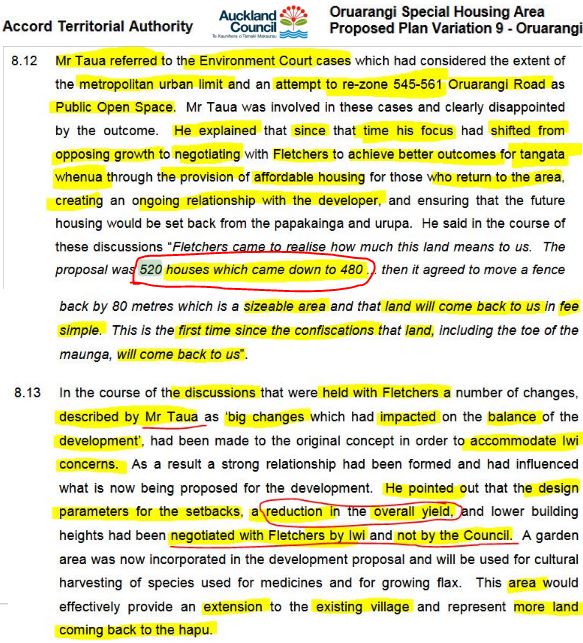
Worse, Te Kawerau ā Maki Iwi Authority chief executive Edward Ashby would later submit in the Environment Court a cultural impact that he prepared in 2015 that set out the tribe’s connections with the Wallace Block at Ōruarangi in Ihumātao. In a May 2016 Housing Accord Territorial Authority hearing, Fletcher Building admitted its Cultural Impacts Assessments were written for them by Te Ākitai Waiohua and the Te Kawerau Iwi Authority and Makaurau Marae Māori Trust. Indeed, Te Warena Taua also wrote a Cultural Impact Assessment for Fletcher Building. These occurrences should have raised red flag about conflicts of interest, followed a finding in a 2015 Council consent hearing that Fletcher Building’s proposal included paying an undisclosed sum to the Makaurau Marae Māori Trust.
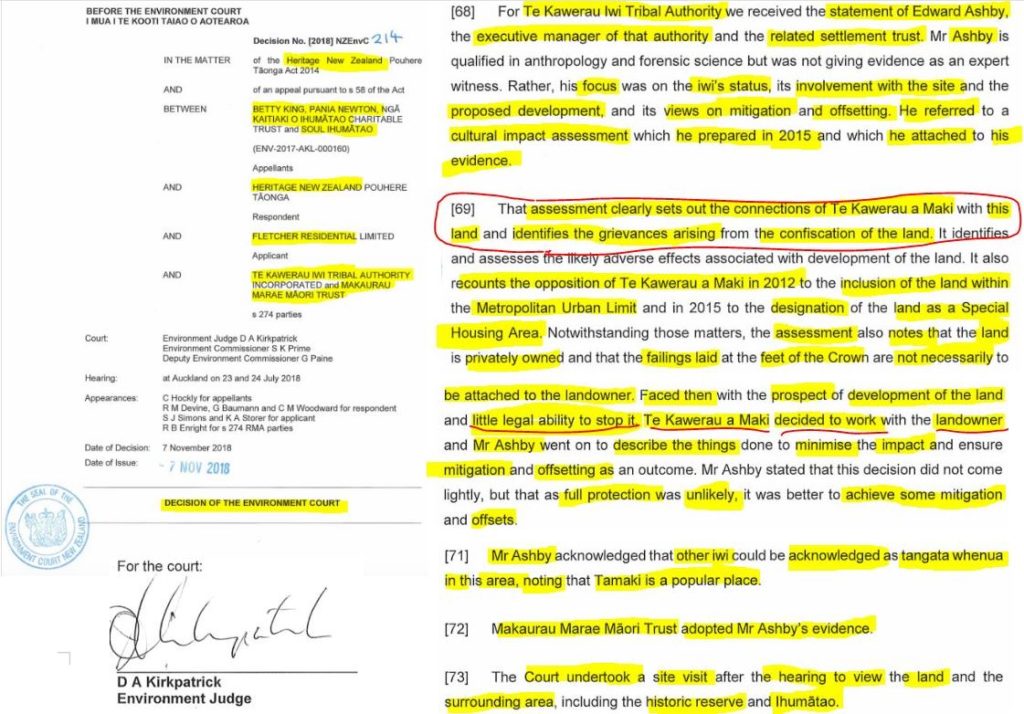
Just five weeks after the Auckland Council’s Accord Territorial Authority reported that Te Warena Taua is the mandated kaumātua in Ihumātao, Mr Taua threatened the Auckland Council with a “major fight” if the Council went ahead with recommendations of an Independent Hearings Panel (IHP) to remove protections of 3000 cultural sites identified in the Unitary Plan blueprint for intensive housing. In an interview with Māori TV‘s Te Kaea news on 28 July 2016, an evidently frustrated Mr Taua asked rhetorically, “What’s the point of Te Waka Anga Mua if they have no authority?” Te Waka Anga Mua ki Uta Maori Strategy and Relations Department advises the Auckland Council on co-governance responsibilities for sites of significance to mana whenua and mataawaka of Tamaki Makaurau. The New Zealand Tax Payers Union campaigned against the Sites and Places of Value to Mana Whenua Schedule in the Unitary Plan naming it the “Taniwha Tax ”.
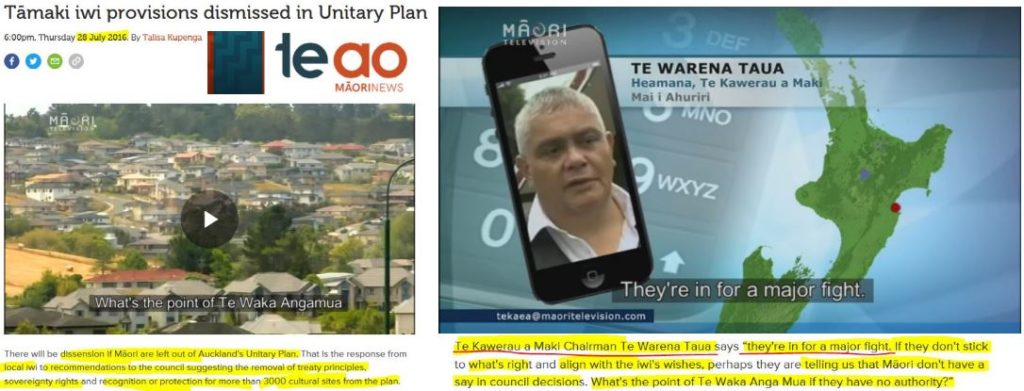
Yet, Fletcher Building’s housing development proposal proceeded without any deep investigation into whether or not the cultural impact assessment work meant there were payments attached that might have doubled as cash bribes, and whether the Makaurau Marae Māori Trust also received bribe money. Furthermore, Environment Court Judge D A Fitzpatrick recounts Ashby’s cultural impact assessment stating it noted that in face of a development that Te Kawerau ā Maki Iwi Authority and Settlement Trust had “little legal ability to stop” the development, the iwi “decided to work with the landowner.” With such fictions throughout, Environment Court Judge Fitzpatrick’s institutionally racist ‘Decision’ meant that Betty King, Pania Netwon and SOUL lost their appeal to have Heritage New Zealand’s archaeological approval of 2017 overturned.
Taua’s chairmanship of Makaurau Marae Māori Trust (2013-2019) is also questionable given his ongoing relationship with Fletcher Building because he has clearly given the construction consortium the impression that Te Kawerau ā Maki Iwi represents the mana whenua of Ihumātao. As late as May 3 and May 7 2019, The New Zealand Herald’s property reporter Anna Gibson quoted Fletcher Residential CEO, Steve Evans, claiming just that and more. In an article headlined, “Ihumātao protesters block Auckland road, vow to stop Fletcher developing 480 new homes”, Gibson quoted the Fletcher Residential CEO, who bragged about a buffer zone being returned to Te Kawerau ā Maki, because they were the only tribe mentioned. Evans PR statement said:
“Returning this land is important to us, and to Te Kawarau a Maki – it will be the first time in a 150 years that their name will be back on the land. We understand that this is the first agreement of its sort between an iwi and a corporate for the return of the land.”
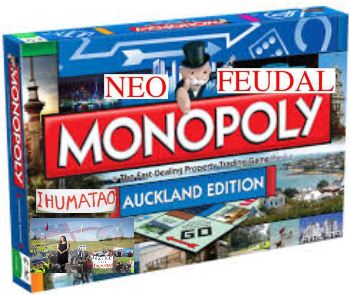
It appears Mr Taua’s presentations about his tribe’s alleged ancestral connections to the whenua at Ihumātao also extend to other pertinent Pākehā parties in the land transaction, such as the Wallace-Blackwell family that own Gavin H Wallace Limited, the company that held private title to the disputed ‘Wallace Block’. In a news article – “Ihumātao protest: Former landowner the Wallace family speaks out against stand-off” – Fairfax‘s Stuff correspondents, Harrison Christian and John Anthony, anonymously quoted the only male director of Gavin H Wallace Limited, John Wallace Blackwell of Dargaville, with a 22.22% stake in the company stated:
“[Te Kawerau a Maki kaumatua Te Warena] Taua, the head of the village, came up with an agreement, a compromise, and got a very good deal, and these other people have come out and put his decision and the housing under risk. It’d be a shame if they lost out.”This [protest] group that’s got going, the information they use is what I’d call very unreliable.
About 80 per cent of that land is ploughable and has all been ploughed and worked and cropped. Māori used to grow wheat to supply the Auckland market in that area. They wouldn’t have done that if it was a burial ground. ”
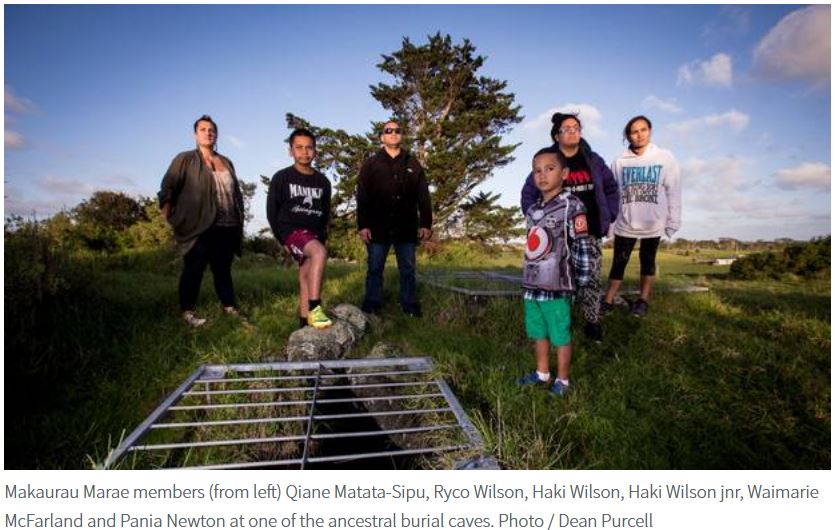
Not only did John Wallace Blackwell not know much about what ‘the six cousins’ knew. He either believed that Mr Taua was “the head of the village” at Ihumātao or pretended to so believe, playing along in a game of contrived ignorance that included using the news media as a transmission vector to propagate public confusion, division and conquest.
The Wallace-Blackwell Family’s role in this land dispute appears to have been deemed ‘sensitive information’. Ironically, in the Environment Court in 2012, Gavin H Wallace Ltd’ claimed any development could be done sensitively on the sensitive land.
It turns that the Overseas Investment Office deemed the matter of ‘Sensitive Land’ has been sufficiently handled with by relying on information supplied to the state agency from the Applicant. In its abdication of robust investigation processes, particularly in light of the ministerial waivers, the Overseas Investment office noted in paragraph 13 that the Office did not seek any verification from “third parties”. Yet, the Overseas Investment Office noted in Appendix 2 that sensitive land included historic places with wahi tapu areas, or if it is adjacent to a historic reserve or wahi tapu places.
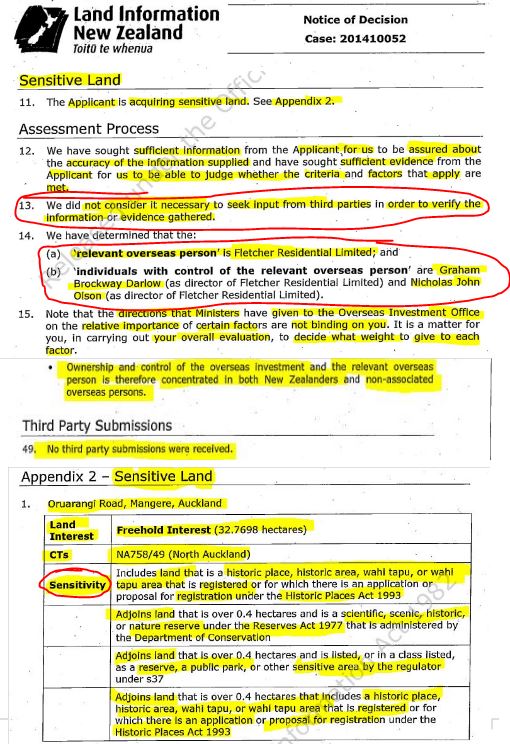
The behind the scenes means with which the Wallace-Blackwell Family dealt with Fletcher Building, however, to reach a conditional sale agreement with consultation with Makaurau Marae, appears to contravene assertions that the development plans were ‘sensitive’. The murkiness with which Wallace-Blackwell Family reached a deal with Fletcher Building, and then the construction company’s subsequent dealings with Te Warena Taua, actually undermined Mr Taua’s prior stance that the land at Ōruarangi was wāhi tapu and should be preserved in pristine condition.

Mr Taua actually presented in favour of the Fletcher Residential proposal at Auckland Council meeting on 27 August 2015, while Pania Newton led a group of 200-supporters to present their 400-signature petition requesting the Council to revoke the Special Housing Area (SHA-62) fast-track zoning that prevented SOUL from opposing the development through many official processes. Taua revealed the Fletcher development would have a mana whenua-owned buffer zone between the housing and the stonefields, ownership of half a maunga, and a possible housing partnership (later 40 houses) and cultural centre. Pania Newton spoke of the ancestral history, the historical suffering of the people at Ihumātao papakāinga, suggested other sites for housing development and asked Council to revoke SHA62.
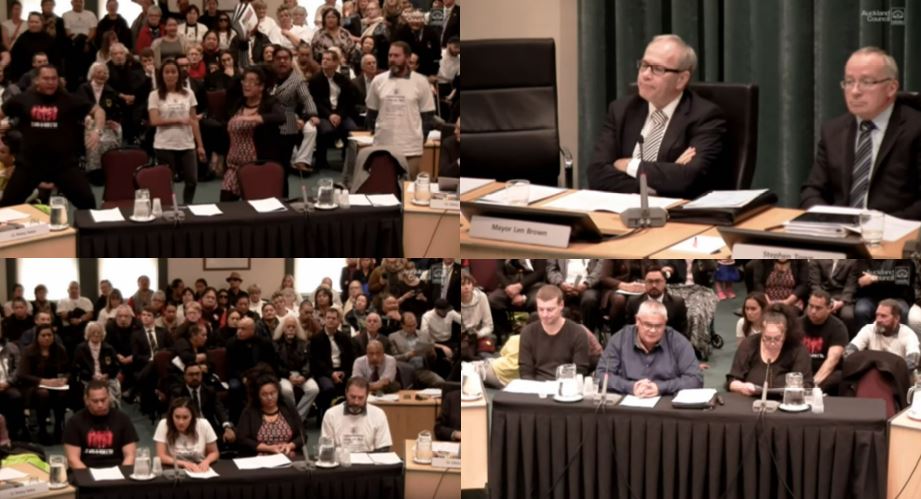
In essence, the then-25 year-old Māori graduate of Auckland University Law School politely told the Pākehā Councillors off, informing them that the Ihumātao community became aware of the SHA zoning after they saw new survey pegs on ‘the Wallace Block’, as Ian Sinclair’s Sunday programme from 2016 showed. Te Warena Taua told the Council, “The only reason we begun to talk with Fletchers was that to change things, there needed to be a – [pause] a law change.” But, of course, Mr Taua was not at the Auckland Council to lobby for a law change – because he had already capitulated. Letters in support for each side of the dispute from the Makaurau Marae Committee were presented – further revealing the deep divisions within Ihumātao.
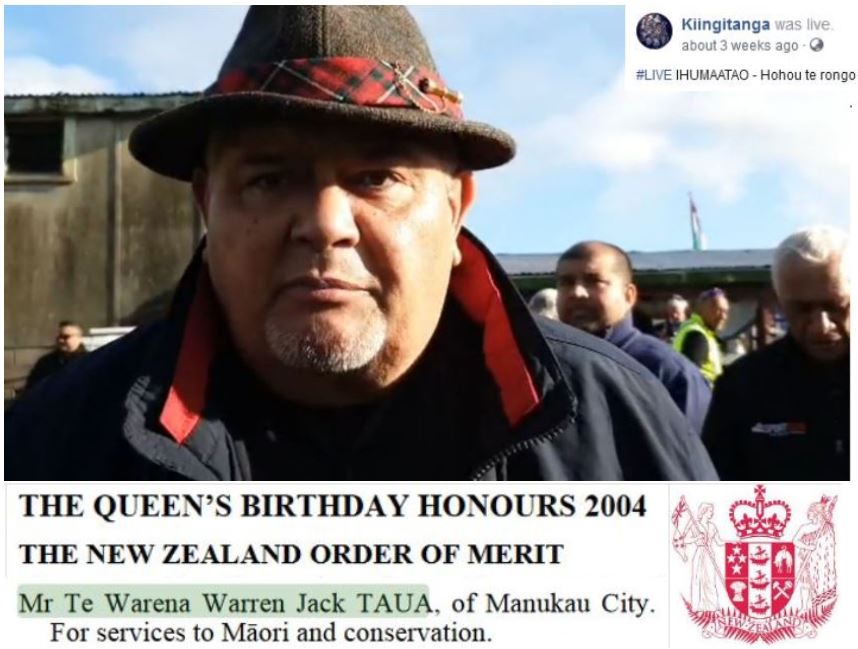
In his piece for Waatea News, Ihumātao | He Raupatu Tuarua | A Second Confiscation, Dr Rawiri Raonui sums up what happened next:
More crucially, a letter was tabled from Minister of Housing Nick Smith, who was concerned about the political ramifications of a reversal for National’s flagship HASHAA policy, said that because SHAs were activated by Orders in Council only he as Minister could revoke them. The motion in the Auckland Council was defeated 12 votes to five. Thirteen days later, Associate Minister of Finance Jonathan Coleman and Minister for Land Information New Zealand Michael Woodhouse approved the OIO application.
In other words, the Minister of Housing was holding the coveted the Dial-a-Kāumatua Card.
The coordinated signing off on the Overseas Investment Office application by the Associate Minister of Finance Jonathan Coleman and Minister for Land Information New Zealand Michael Woodhouse – thirteen days after the Auckland Council vote against revoking SHA designation – actually shows SOUL’s showdown on August 27 2015 was a critical institutional hurdle for the transnational banked-owned Fletcher Building corporation to leap over. Therefore, Mr Taua’s support as the ‘mandated kaumātua’ on three committees across three iwi/hapū groups on one marae, supplied the essential ‘Maoriness’ – as Dr Rawiri Raonui put it – that the Auckland Council, and subsequently, the Overseas Investment Office, Heritage New Zealand, and the Environment Court needed to grant their approval.
Furthermore, Taua’s judgment in continuing to work with Fletcher Building is questionable given that it is publicly known that Fletcher Building threatened Heritage New Zealand after being turned down on two applications for archaeological approval. The construction consortium stated it would seek a judicial review if its third application was unsuccessful, as Dr Taonui noted in his article “Ihumātao | He Raupatu Tuarua | A Second Confiscation” on Waatea News. Heritage New Zealand granted the authority in September 2017. Heritage New Zealand’s capitulation to Fletcher Building’s coercive threat meant it abdicated its responsibility to protect a site of national historical significance.
Play Your Contrived Ignorance Card
Mr Taua’s ‘about-face’ after losing in the Environment Court in 2012 requires closer scrutiny because his impact in spreading the impression that Te Kawerau ā Maki is the local iwi at Ihumātao has been pervasive. This fraudulent posture can be seen in another article “The Detail: Why Ihumātao has opened up rifts among Māori – How Ihumātao went from a precious garden to a battleground” that was reproduced by Fairfax‘s Stuff after it was published by Newsroom on July 30 2019 in association with RNZ. In its regular feature The Detail, Newsroom‘s Ihumātao explainer incorrectly positioned “Te Kawerau ā Maki [as] the local iwi.”
Ironically, in its Deed of Settlement of Historical Claims, Te Kawerau ā Maki Iwi did not claim to have owned any land on the Ihumātao Peninsula and only mentions the location twice in passing.
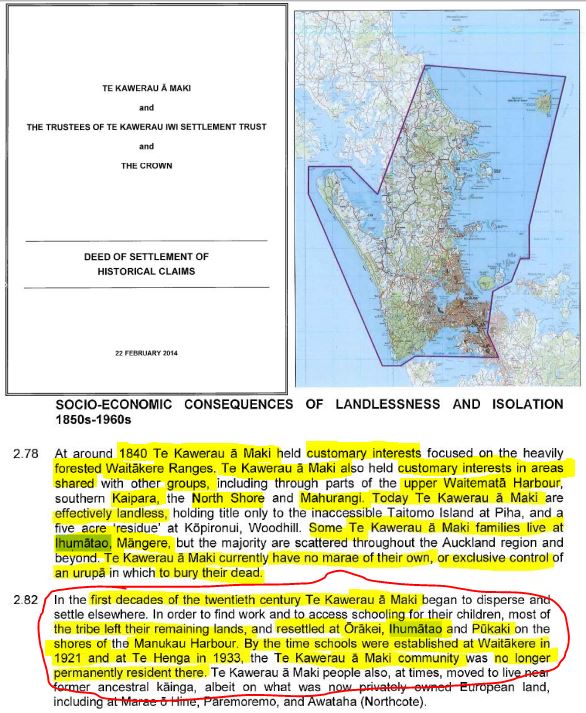
Te Kawerau ā Maki tribe’s own Waitangi Treaty Deed of Settlement states that it was not until “the first decades of the twentieth century … Te Kawerau ā Maki left their remaining lands and resettled at Ōrākei, Ihumātao and Pūkaki.” The document stated that some of the tribe’s families live at Ihumātao. The iwi also described itself as a landless, marae-less iwi, which means in tribal terms, Te Kawerau ā Maki were a homeless indigenous people. The tribe’s traditional stronghold was the Waitakere Forest, Murawai, and Te Henga/Bethells, with customary interests in parts of the upper Waitemata Harbour, Southern Kaipara, the North Shore and Mahurangi.
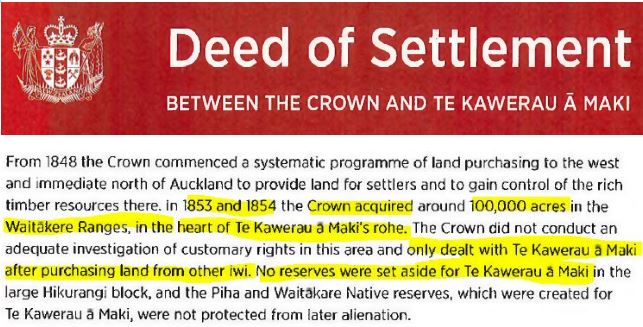
The mandated signatories to Te Kawerau ā Maki Deed of Settlement included members of Te Warena Taua’s family, while Te Warena Taua MNZM was recognized as the mandated negotiator for the Te Kawerau Iwi Tribal Authority.
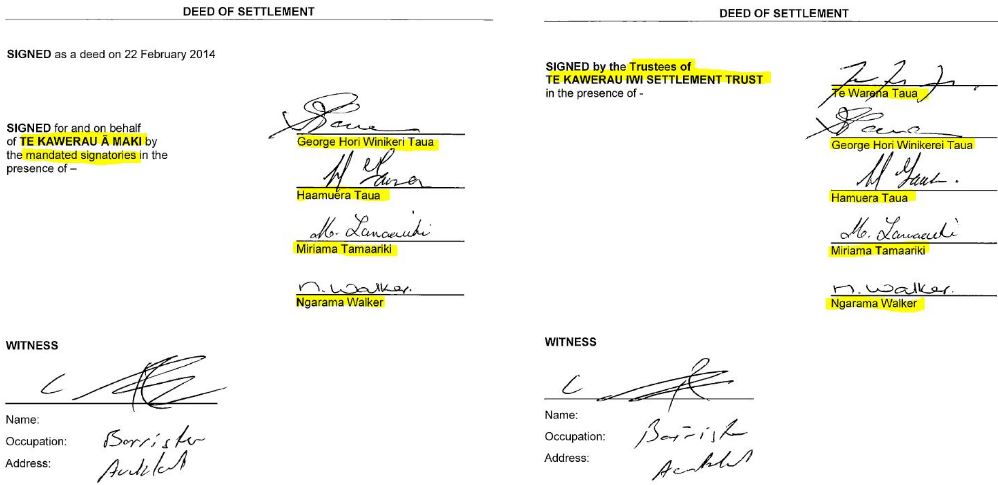
The Area of Interest [depicted in the map above] shows where Te Kawerau ā Maki exercises kaitiakitanga for the purposes of the Resource Management Act 1991, which governs how the Environment behaves or otherwise, and was agreed between Te Kawerau ā Maki and the Crown in the Deed of Settlement signed on 22 February 2014. The Deed of Settlement did not mention Ōtuataua Stonefields Historic Reserve, nor Ōruarangi at Ihumātao, and therefore made no claim to being mana whenua at Ihumātao and Makaurau Marae. Rather, the Deed Settlement includes a Māori reservation at Te Onekiritea Point in Hobsonville to build a marae and specifically claimed ancestral heritage to Te Henga/Bethells with land signposted for an historic reserve and fee simple land for Te Kawerau ā Maki to build a marae (which the Waitakere Council bought in 2009 for the iwi) – as well as registering fee simple sites at Swanson, Henderson, and Murawai.
Yet, Te Kawerau ā Maki’s ancestral rohe, or area, were known to at least three members of the Labour Māori Caucus, whom are prominent ministers in the Ardern Coalition Government – at least as far back as September 2015. Despite their knowledge that Te Kawerau ā Maki were not the tangata whenua of Ihumātao, three Māori lawmakers in the Ardern Coalition Government kept quiet that they knew Te Kawerau ā Maki’s traditional territory was in the Waitakare Ranges, the South Kaiparara Harbour and the North Shore in the upper Waitemata Harbour area. Davis, Mahuta, and Henare withheld this knowledge from the New Zealand people during the Ardern’s press conference of Friday evening July 26th 2019 – when she announced a halt to building at Ihumātao.
On Friday July 26 2019, in a press conference, NZ PM Jacinda Ardern appeals to rangatahi to respect the land at Ihumātao, while calling a halt to Fletcher’s bulldozers scraping the land at Ihumātao. Meanwhile, her Māori Labour Caucus stay silent about how and why exactly Te Kawerau ā Maki’s mandated kaumātua, Te Warena Taua, had become Fletcher Building’s Dial-a-Kaumātua. Ardern emphasized the need to de-escalate the stand-off and to facilitate a resolution.
The palpable paternalism in Jacinda Ardern’s statements were unwisely amplified with dog-whisting, when she also insulted SOUL’s campaign supporters, saying, “We just ask that they be respectful, that they look after the land that they will be visiting.”
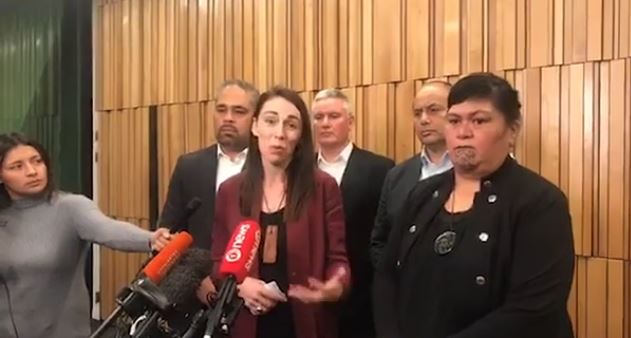
Yet two days prior, in a MaiFM interview on July 24, NZ’s PM, could not bring herself to even mention the Protect Ihumātao campaign group’s name – Save Our Unique Landscapes (SOUL). On MaiFM, Jacinda Ardern said, “they’ve … gone through every avenue”, “it’s hard when we don’t have always all of the solutions available to us” and adding “my jobs [sic] is just to fix the ones that are squarely in my court”. The solution was to be found in the hands of Council and other parties involved on MaiFM – she told every news outlet – until she changed her tune on Friday 26th.
.
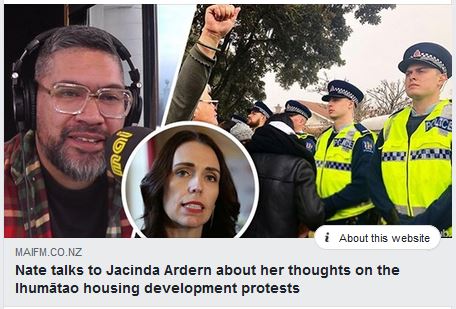
As can be seen from their own statements, at least three key members of the Māori Labour Caucus made statements in NZ’s parliament on September 8th 2015 to the effect that Te Kawerau ā Maki were a landless iwi with no marae and that their ancestral whenua was not in the Manukau Harbour – as can be seen in the transcripts of their speeches during the third reading of the Te Kawerau ā Maki Claims Settlement Bill. Indeed, they heard Chris Finlayson introduce the bill with a summary of the loss of their territories in the Waitakare Ranges, the South Kaiparara Harbour and the North Shore in the upper Waitemata Harbour area – due to the Crown’s machinations in the Colonial and Dominion eras.
Even former Waitakere City Mayor, Bob Harvey, was present, standing to Te Warena Taua’s left, in the public gallery – a fact noted by several politicians, including Chris Finlayson. To twist my pen-sword deeper, the former mayor of Manukau City, Barry Curtis, was not in the public gallery on September 8 2015. The absence of confusion in Parliament about Te Kawerau ā Maki ‘s ancestral lands being in the South Kaipara district, the upper Waitemata Harbour and the Waitakere Ranges occurred just one week after Mr Taua had presented in favour of the Fletcher Residential proposal at the Auckland Council meeting of 27 August 2015. In other words, at the very time that Mr Taua’s efforts to fight for his iwi to gain land for a marae at Te Henga/Bethells, he had used his position as chair of three committees across three iwi/hapū groups on one marae at Ihumātao had successfully to write favourable Cultural Impact Assessment to assist the fast-track re-zoning for development.

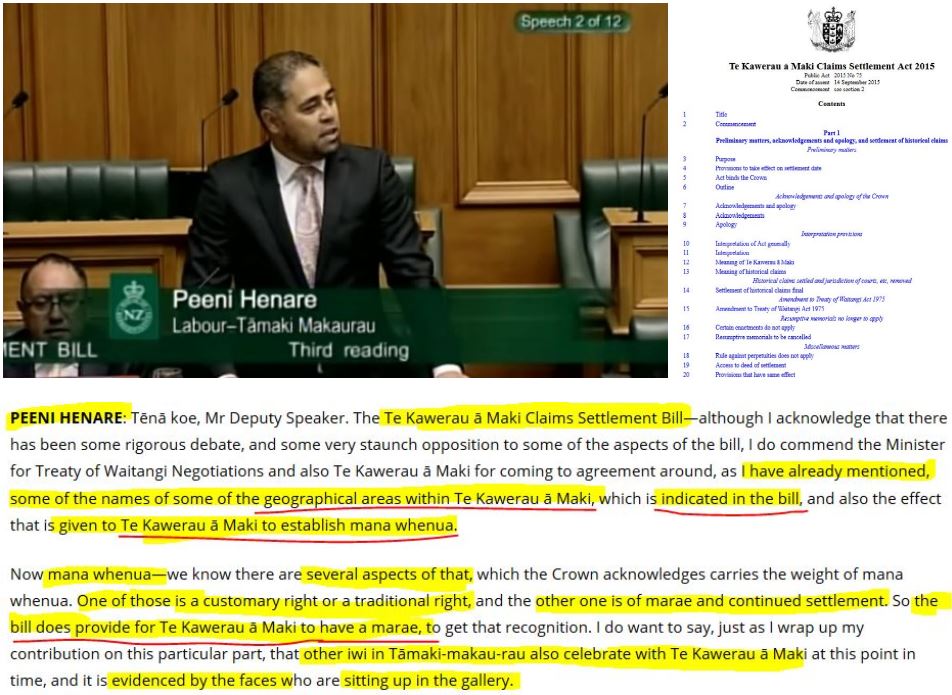
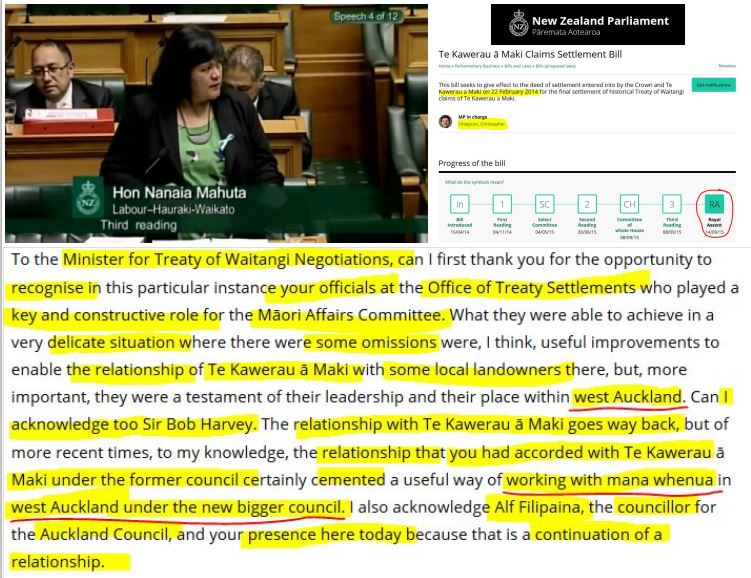
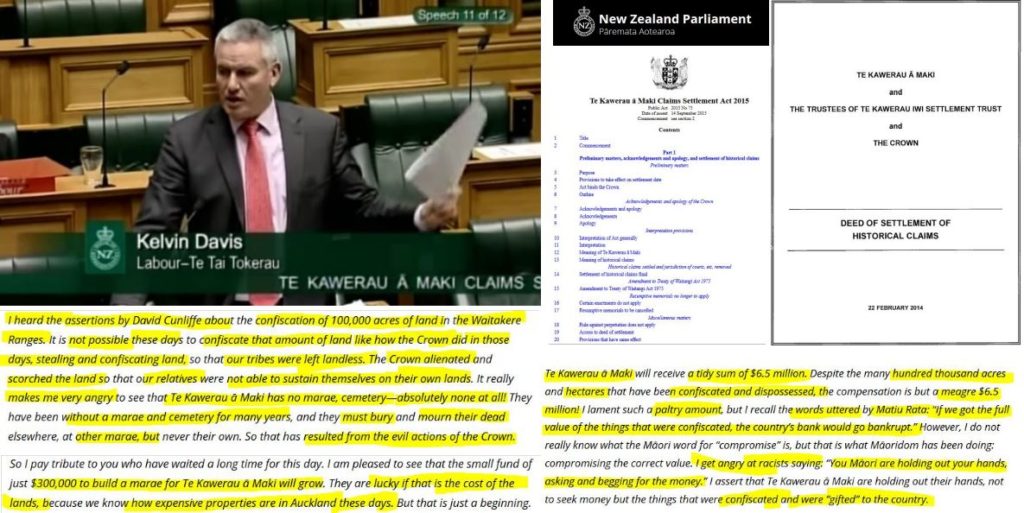

This means the Ardern Coalition Government enjoined itself in the contrived ignorance game of the Auckland Council, the Courts and other Crown agencies whom pretended that Te Warena Taua represented the local iwi of Ihumātao.
Ironically, on Monday August 5 2019, the Labour Party’s Tāmaki Makaurau MP confided to Victoria University students that, “More deals are done in the Koru Lounge than on the Marae”. Peeni Henare, who is in charge of managing civil emergencies as the Minister of Civil Defence, added, “This is a wakeup call to leadership in this country – both Maori and otherwise. Our people won’t tolerate this anymore… Backroom deals have to stop.”
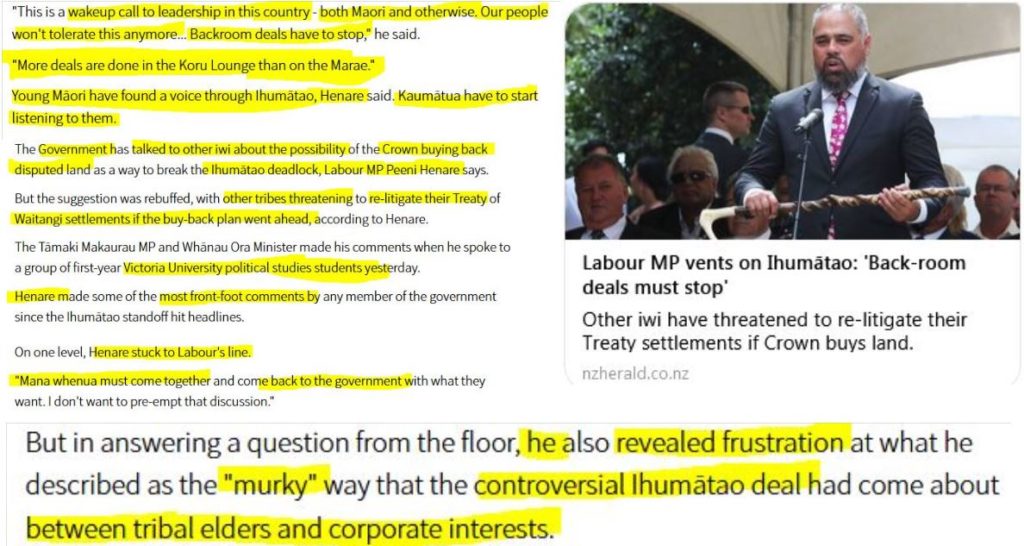
On August 21 2019, the morning of a 21-kilometre march from Ihumātao to Jacinda Ardern’s Mt Albert electorate office, Duncan Garner on Newshub went live with a ‘scoop’ that Tainui were going to buy the land. This ‘scoop’ fizzled by lunchtime. But, Garner’s ‘breaking news scoop’ involved the curious reappearance of former Treaty Negotiations Minister Chris Finlayson in the studio – the morning of the hikoi – listening on headphones to Garner’s interview with Pania Newton.
On the AM Show, Finlayson suggested that Tainui iwi buy the land for a Novotel Hotel with an 18-hole golf course. Finlayson inoculated his politely racist dog-whistling saying, “[Tainui] could think about an appropriate development there that takes into account all the concerns Pania has mentioned.”

Inoculation is a public relations tactic used to acknowledge the inherent weakness of a manipulative argument, with the idea of quickly moving on. It relies on news media complicity, fast news cycles, as well as reporters lacking bravery to call-out such subtle jabs from quick pricks that do their work while appearing to cause little pain. The former Treaty Negotiations Minister said Tainui has lots of money.
Finlayson’s role as a Minister of Treaty-Settlements-Past is fascinating. As Naomi Klein noted in her 2007 book, The Shock Doctrine, there’s a pattern around the world she noticed. Former officials of ‘crises-past’ often appear at moments when new crises emerge to attempt to take control of the narrative. Therefore, Finlayson’s presence was a codified communication that signalled that the Ihumātao issue has the potential to snowball into a fully fledged crisis. The appearance of this former official from a crises-past shows that the Pākehā-dominated Rich-Lister ruling class of New Zealand are worried about the Ihumātao issue re-opening claims that Ministers such as himself have been happy to call ‘full and final’ – knowing they were paltry and unfair settlements in comparison to the value of territories, economic exclusion and treasures lost. Moreover, former Officials of Crises-Past can make misleading remarks where current officials could injure the Crown for the inherent deceptions in manipulating public opinion.
The resolve of the Ihumātao whenua protection group, Save Our Unique Landscapes (SOUL), to take their fight to numerous Crown, Council and Court forums has revealed that institutional racism is endemic to the Neo-Feudal governance systems. The horrendous decisions show that N.Z.’s Pakeka-dominated institutions are adept at short-circuiting attempts by maori to regain lands that were stolen, swindled, or lost by stealth.
Play Your Race Card to Ensure Tangata Whenua Remains Just a Phrase
The tolerance for racism in N.Z.’s governance institutions can be scene in a November 2018 Environment Court decision.
Audaciously, Fletcher Building had challenged Pania Newton’s “standing” in the Environment Court, as the Court’s November 2018 report records – without cringing with embarrassment.
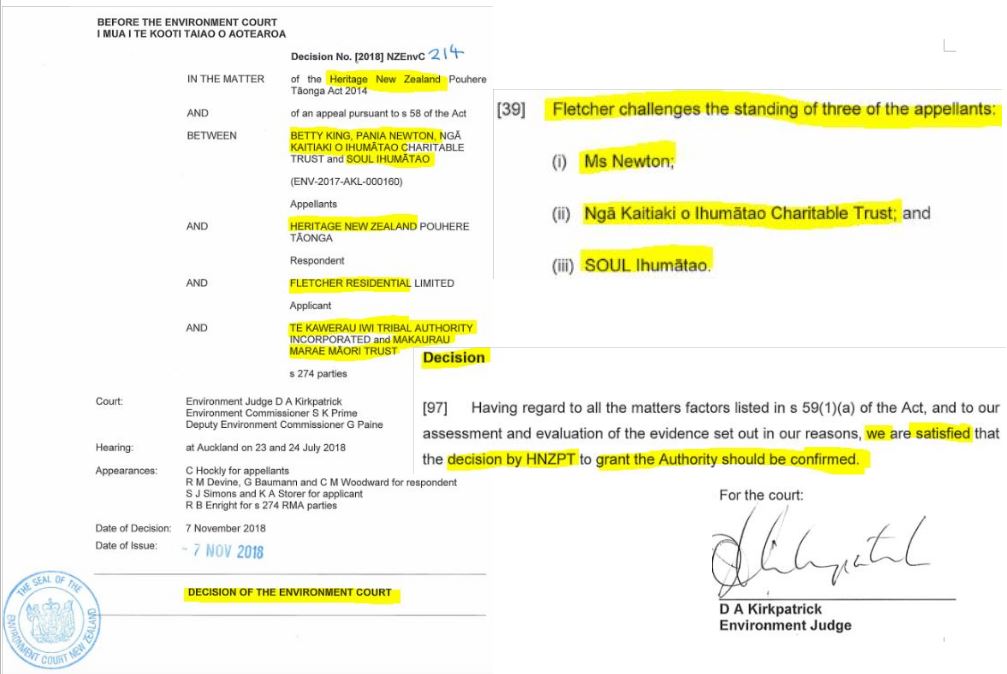
Because Pania Newton is one of ‘the six cousins’ — whose stomping ground as tamariki is the papakāinga at Ihumātao, the Environment Court should have known by late 2018 that Newton’s pedigree, since it was reported, for instance in October 2015, that she and her cousins grew up at Ihumātao village “where around 80 families trace their descent to Te Waiohua and Te Ahiwaru of Tainui waka.” That report “Sacrifices but no reward” was filed by multi-award winning journalist Wena Harawira (who started out as a seventeen year-old under the wing of none other than multi-season One Network News anchor, Judy Bailey [1987-2003], of Pākehā-household-name-fame). Moreover, at the very place of the occupation, Puketapapa, one of Newton’s tupuna or ancestors, lived – as she told Vice Magazine in mid-2017, in a story “Taking the Fight for Ihumātao All the Way to the United Nations”. This tupuna is no less a figure than Te Aho o te Rangi Wharepu, son of Pōtatau Te Wherowhero — the first Māori King, who was elected to the position at a ‘monster Maori gathering’ Ihumātao in mid-1857. Chief Te Wherowhero, who was the only chief at the time with the necessary mana to establish a Kingship — reluctantly agreed — and was elected with a clear mandate: place a tapu, or sacredly tabu decree, over Māori lands to halt further sales to the Colonial Crown, Pākehā settlers and colonization companies.
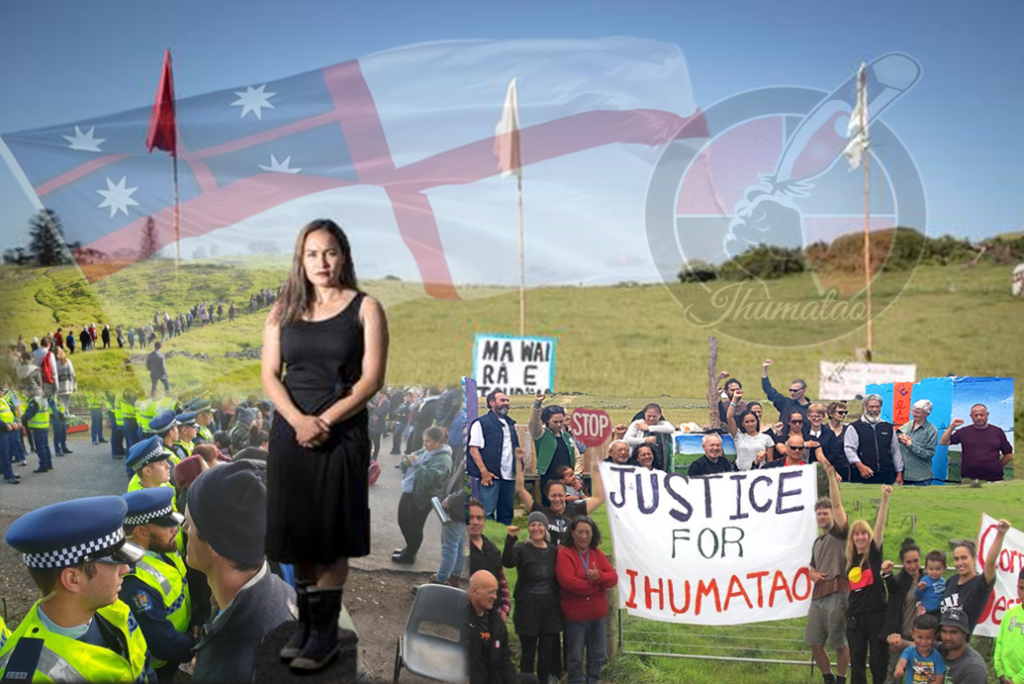
To put ‘the six cousins’ in the correct context of the campaign to halt the destruction of Puketapapa, or the Ōruarangi Block, they are the ahi kā kaitiaki, or whenua guardians, who have led the re-occupation of the land following a Makaurau Marae hui in February 2015, with a core campaign crew of 50, to keep the home fires burning. Newton also told Vice Magazine in mid-2017 that her whakapapa extends back 28 generations to her tupuna, Hape, who evidently beat the Tainui Waka to Aotearoa/New Zealand in 1300 by riding a stingray that was conjured for him by Tangaroa, god of the sea. Evidently, Tangaroa answered his prayer after his iwi had left without him because he had clubbed feet, as Qiane Matata-Sipu told New Zealand Geographic. Upon arrival, Hape planted a tree at the four ‘the corners’ of Ihumātao, to show his iwi he was the man who didn’t need a wooden waka to travel overseas (knowing they would land there after they crossed through the portage at Ōtāhuhu isthmus between the Waitematā and Manukau harbours). Legend has it that Hape walked with clubbed feet to a ridge on Maungawhau [Mt Eden], and saw the Tainui Waka coming into the Waitematā Harbour and so he performed a chanted welcoming summons, or karanga. (The ridge was called Karanga-ā-Hape after which Karangahape Road, located at the top end of the Auckland CBD, was named). With an ancestral heritage of the first Māori King, Pōtatau Te Wherowhero, as well as the Tainui tohunga dude whose job it was to bless the Tainui Waka before its epic voyage to Aotearoa, and who was clearly gifted with spiritual Tohunga Powers to direct dial the god of the sea — if not other Atua — you have to ask: what was Fletchers thinking – or reading or consulting?
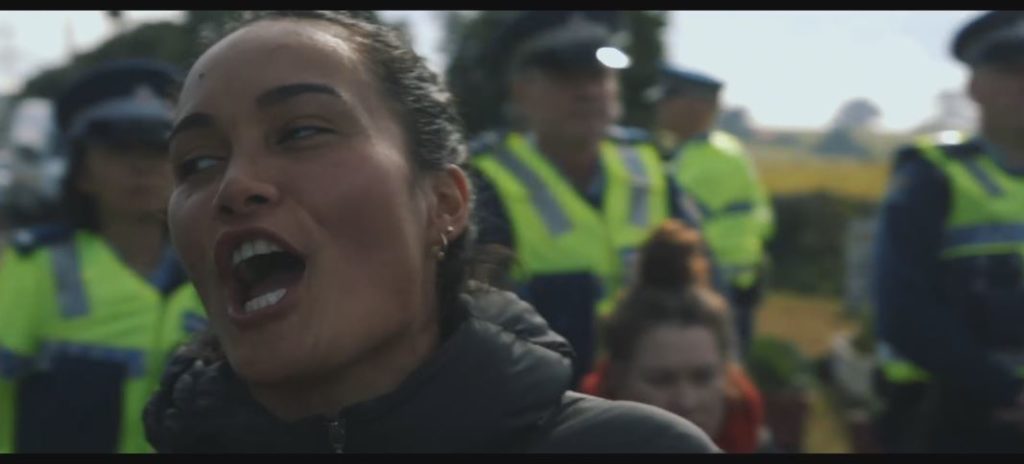
Therefore, Fletcher Building’s dismissive attitude toward Newton and SOUL was a politely racist way of saying that the transnational bank-owned construction cartel does not respect those Māori who oppose their profit-autistic, collusion-ridden business model — by directing sunlight on their ‘Formica Maori’ finish to pass the political hygiene tests of various institutionally racist ‘public’ governance authorities, whom collude to get a development over the line.
Buy the ‘Then and Now Edition’ – For Ruling Class Pākehā Families Only
It is, therefore, ironic that when the disputed land at Ihumātao was originally lost in 1863-1866 period in the midst of what was, in fact, the New Zealand Masonic Revolutionary War – the land was far better advertised.
When the parcels of fertile land at Ihumātao were swiftly bought by Gavin Struthers Wallace at an auction held by the Waste Lands Office on July 17th 1866 – they were designated as Lot 13 (175) and 14 (176) in advertising.
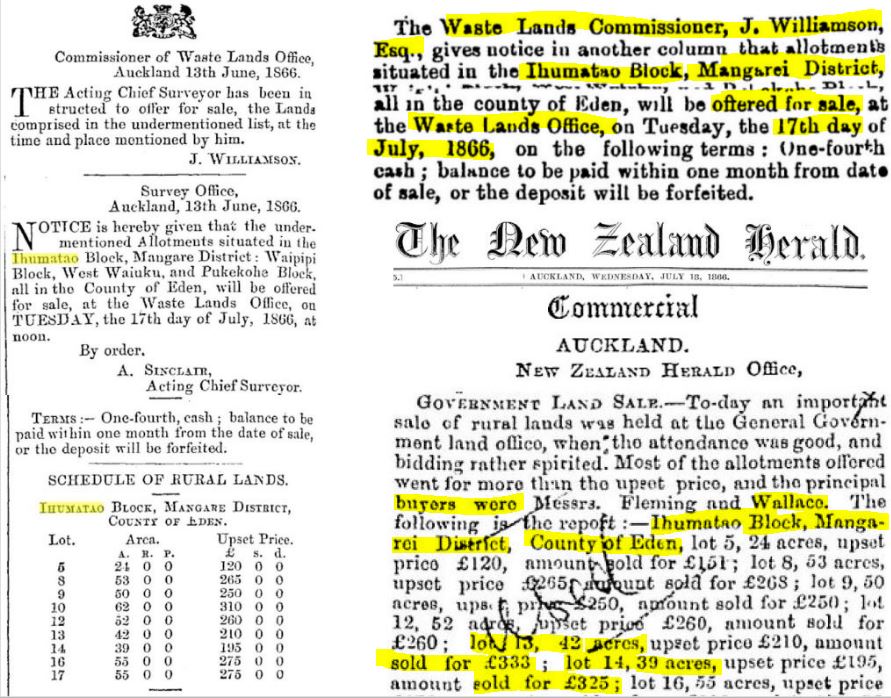
This sale – which was sealed as a Crown Grant on 28th December of 1867 – bears the signature of no less a figure that the Governor of the Colony and Commander-in-Chief of the Armed Forces, Freemason Bro. George Grey (as shown above). Ironically, Bro. Grey signed this land grant a month after he himself received notice of his recall as Governor of the colony to return to London.
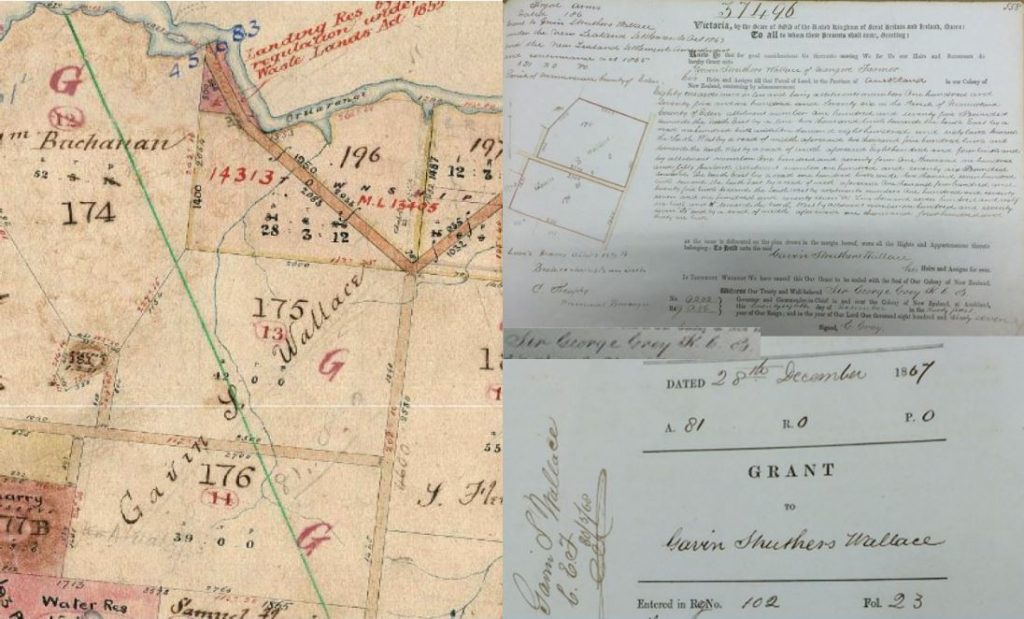
Previously, in March to May 1866, the Native Compensation Court proceedings callously decided the lands at Ihumātao were forfeited because of “defection” to the so-called rebellion by “certain relatives and clansmen” of two great families. There were several Gazette Notices to auction the lands that stated the lot numbers, as The Snoopman showed in “Deep History of Ihumātao: The Methodist Connection”.
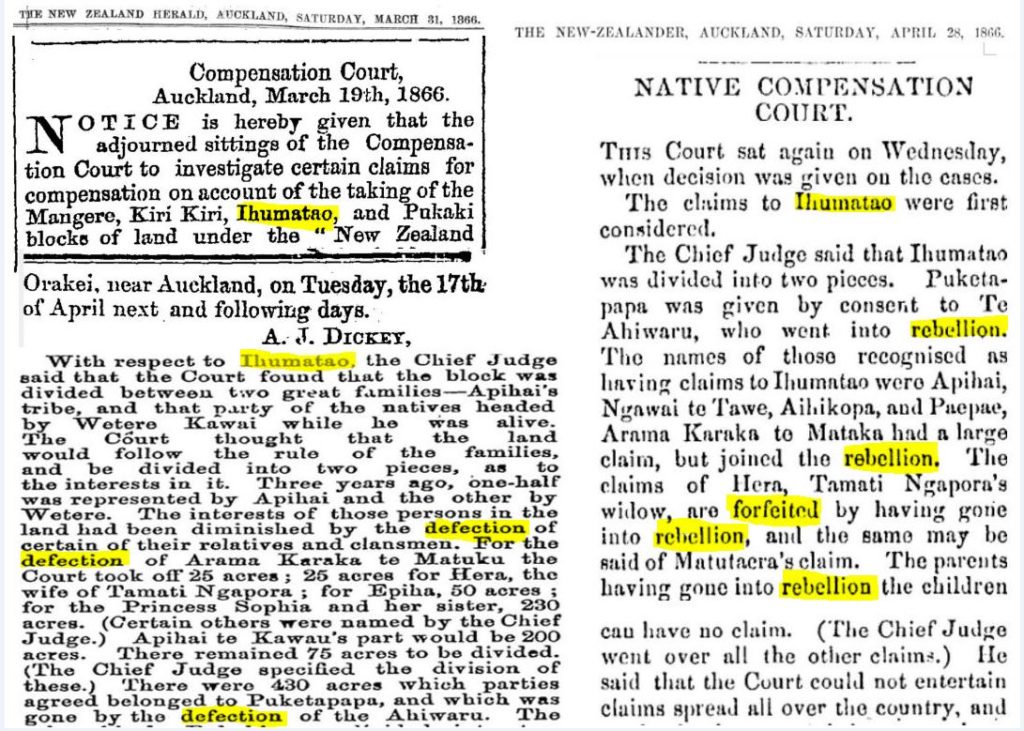
These Gazetted notices followed Freemason Governor Bro. George Grey’s eviction proclamation of July 9th 1863, and a confiscation Order in Council of May 16th 1865.
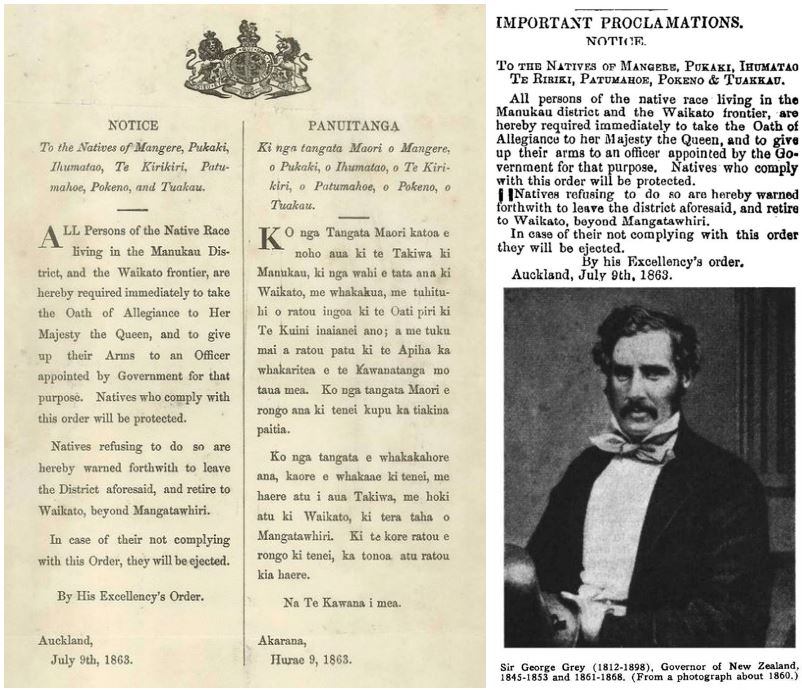
On July 23 1863, the Auckland Naval Volunteers seized eight waka at Ihumātao, Oruarangi and Pūkāki on the Manukau Harbour, after ‘the Natives’ of the Mangere District were served an ‘eviction notice’ 13 days prior, on July 10. This ultimatum by Proclamation demanded Māori of the Manukau District – and elsewhere in the southern parts of the Tamaki region – to pledge loyalty to the ‘British’ Queen, Victoria of Saxe-Coburg and Gotha, and to hand over their weapons.6 Because the Auckland Naval Volunteers confiscated their water transport, Māori of Ihumātao were forced to walk to the Waikato where war was being waged against the indigenous people of New Zealand by Imperial and Colonial forces under the command of Freemason Governor Bro. George Grey.
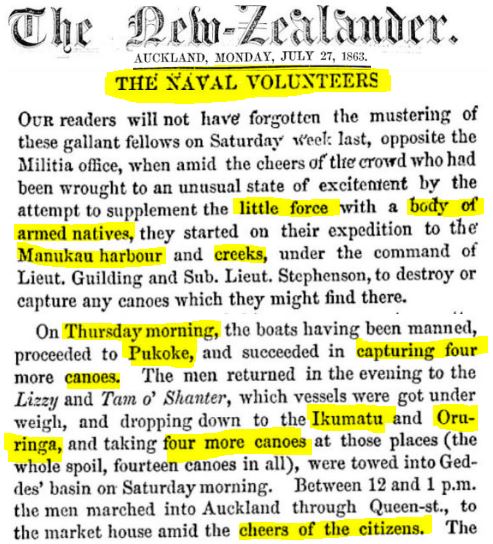
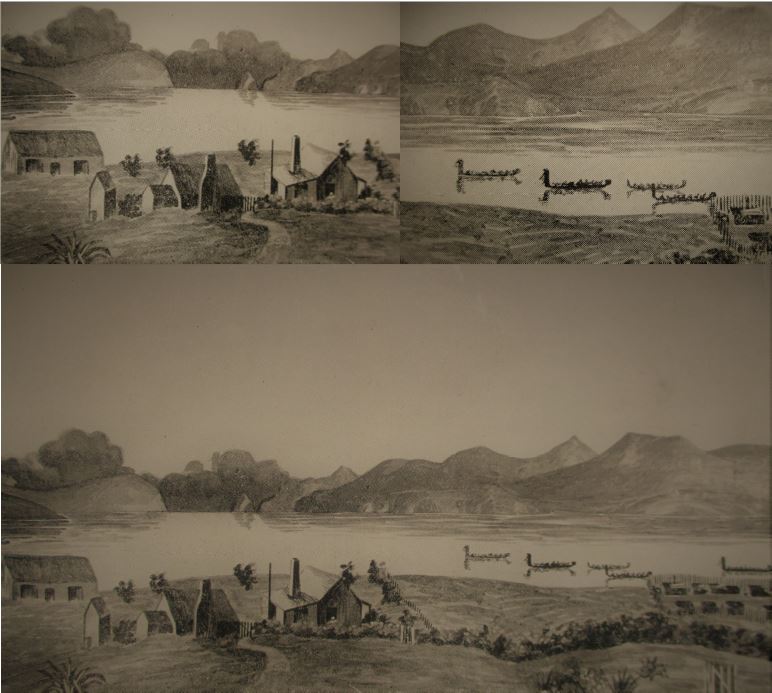

Historian Vincent O’Malley who wrote The Great War for New Zealand – Waikato 1800-2000, emphasizes that the Waikato War really started at Ihumātao – before the shooting commenced following General Duncan Cameron’s troops crossing New Zealand’s version of Rome’s Rubicon River – the Mangatawhiri River– an awa that Governor Bro. Grey knew demarcated Waikato Māori territory and that if crossed it was a ‘point of no return’ – without provoking war. When war preparations were completed a few days ahead of schedule, Governor Bro. Grey moved ahead with plans to confiscate Māori lands that were discussed at an executive meeting on June 23 1863.
On July 23 2019, 150 New Zealand Police supported a district court bailliff to serve a trespass notice on tangata whenua occupiers at Ihumātao, located by the Manukau Harbour in Auckland City, or Tamaki Makaurau. The court-ordered trespass notice demanded the “squatters” group – Save Our Unique Landscapes – vacate an 81-acre block of land confiscated off Māori in 1863-1866 during the Great War for New Zealand.
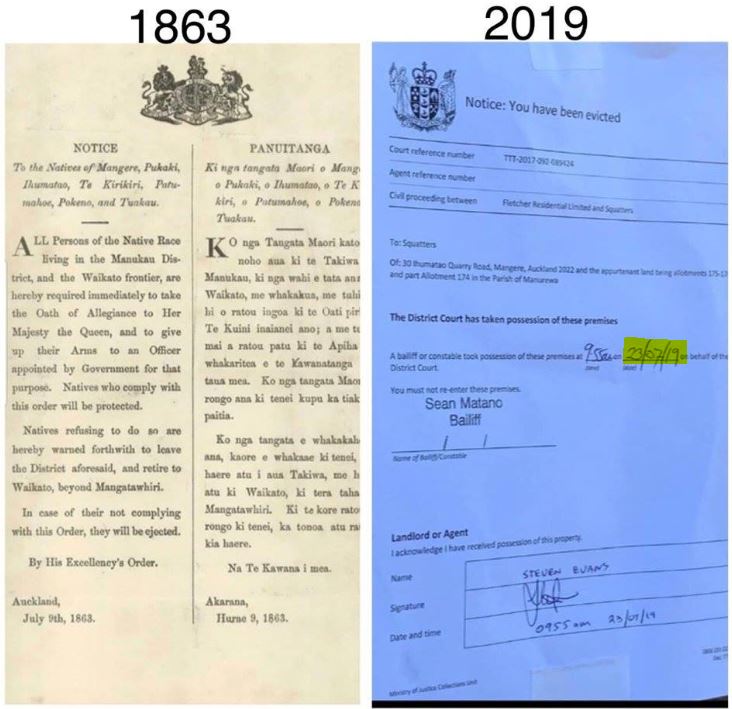
On July 23 2019 – and on the same day that 100 New Zealand Police moved on Ihumātao to serve a trespass notice on the indigenous occupiers – the élite of the large corporatized Waikato Tainui tribe, including King Tuheitia, were at the launch of the Te Arikinui Pullman Hotel Project near Auckland International Aiport – just five minutes drive from Ihumātao.
As none other than Te Warena Taua spoke, a Policeman seated in the front-row was chuckling while the kaumatua of Te Kawerau a Maki made his korero amusing.
It turns out this Policeman is none other than Deputy Commissioner Wally Haumaha. This ground-breaking ritual event was also broadcast on the Māori King’s Kiingitanga Live Facebook channel. In other words, the Te Kawerau a Maki kaumatua, Warren Taua – who was on the scene at the early morning the Police eviction at Ihumātao, and later on the day of July 23 – Mr Taua was also speaking at the Te Arikinui Pullman Hotel ground-breaking ritual – and was filmed at both locations by the Kiingitanga Live Facebook channel.

Meanwhile – the SOUL campaigners a few miles away anxiously called-out via social media and other mediums for support to bolster their front-line resistance to the Police Constabulary’s counter-occupation.
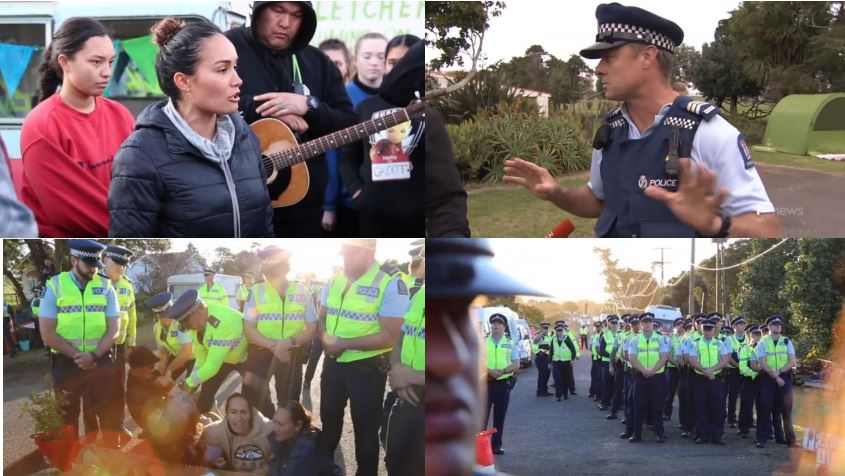
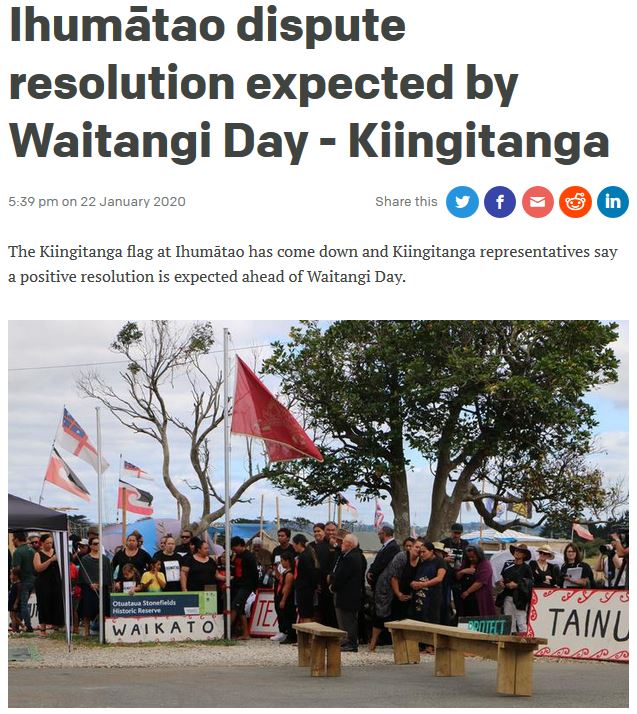
With the Waitangi Anniversary approaching, an announcement is expected in the coming days that a resolution has been reached. Amid the groundswell of public support following the July 23 attempted-eviction, arrests and resolve of SOUL, the Crown, Council and Fletcher Building moved swiftly to contain the Ihumātao Land Scandal to de-risk it snowballing into a full-blown crisis. In playing its De-Escalation Card, the Crown sought to control the crisis narrative by de-risking exposure of the horrendous full story of machinations deployed by the Crown, the Auckland Council and the Courts to stymie tangata whenua attempts to assert cutomary rights over the disputed land. By doing so, the Crown has attempted to short-circuit the dominant Pākehā population, and recent immigrant population finding out how exactly private land buybacks for were taken off the country’s Single Mandated Negotiating Table in 1995 – as The Snoopman investigated in “Fraught Precedents for Land Buy-Backs”. Furthermore, the Crown has been anxious to avoid Māori land rights becoming a topical issue in this election year, because if it is forced to admit to the nation that rangatira who signed the 1840 Waitangi Treaty did not cede sovereignty to the British Crown, then the New Zealand Crown will likely lose its Sole Sovereign Power Card.
If the Crown were forced to relinguish its Sole Sovereign Power Card, the Neo-Feudal Monopoly game would end.
Editor’s Note: Please let our intern, Steve Edwards, know if we have made any errors. e: steveedwards555@gmail.com
In this exposé – “Deep History of Ihumātao: The Fletcher-Rockefeller-Rothschild Dynasties Connection [Mud-sticking version]” – Fletcher Building’s corporate ancestry, cross-institutional linkages and cross-ownership are revealed as an intriguing web of conniving corporate networks, hidden spidery machinations and conspiratorial structural racketeering. This investigation reveals the who, and the why of how exactly Ihumātao became designated as a Special Housing Area amid a housing crisis in the world 39th-ranked Global City.

================================================
“Te Warena Taua – The mandated kaumātua who authored his own use-by-date?” https://snoopman.net.nz/…/ihumatao-class-lesson-003-te-war…/
Ihumātao: The Fletcher-Rockefeller-Rothschild Connection & the Crown’s Crimes Act Breaches [Letter to NZ PM Ardern]
https://snoopman.net.nz/…/ihumatao-the-fletcher-rockefelle…/
Deep History of Ihumātao: The Fletcher-Rockefeller-Rothschild Dynasties Connection [Mud-sticking version]
https://snoopman.net.nz/…/deep-history-of-ihumatao-the-fle…/
Deep History of Ihumātao: The Freemason Connection
https://snoopman.net.nz/…/deep-history-of-ihumatao-the-fre…/
Deep History of Ihumātao: The BNZ Connection
https://snoopman.net.nz/…/deep-history-of-ihumatao-the-col…/
Deep History of Ihumātao: The Methodist Connection
https://snoopman.net.nz/…/deep-history-of-ihumatao-the-met…/


